Bangladesh is home to an incredible variety of bird species, from the majestic Bengal Florican to the tiny Asian Palm Swift. With over 700 species of birds, Bangladesh is a true paradise for bird-watchers, offering a rich and diverse avian life that can be found in both urban and rural environments.
From the vast wetlands of the Sundarbans to the tea estates of Sylhet, Bangladesh is a bird-lovers paradise, boasting some of the most beautiful and rare species in the world.
1. Oriental Magpie-Robin
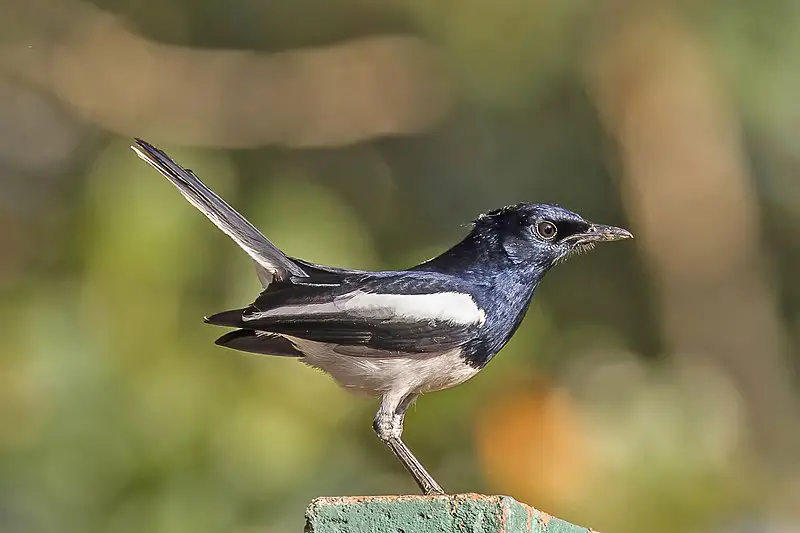
The Oriental magpie-robin is a beautiful passerine bird found across the Indian subcontinent and parts of Southeast Asia.
It can be easily identified by its black and white plumage, long tail that it holds upright while perched or foraging on the ground.
They are known to sing melodiously which makes them popular as cage birds in many countries.
These birds feed mainly on insects but also consume fruits, berries and nectar from flowers during certain times of the year.
Their population numbers have been declining due to destruction of their natural habitats like deforestation.
However, conservation efforts have seen some success in recent years with more areas being set aside for protection and preservation.Scientific classification:
| Kingdom | Animalia |
| Phylum | Chordata |
| Class | Aves |
| Order | Passeriformes |
| Family | Muscicapidae |
| Genus | Copsychus |
| Species | C. saularis |
Also Featured In: Hong Kong Birds You Need to See, Black And White Birds You Don’t Know About
2. Common Myna
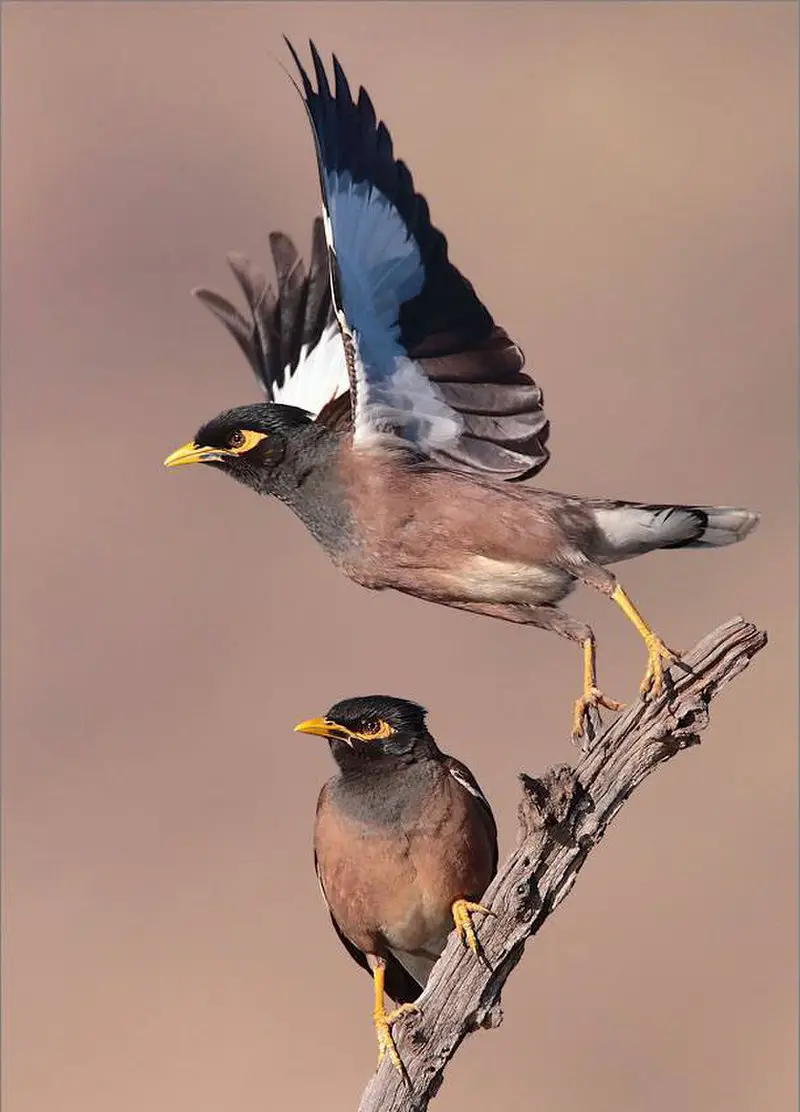
The Common myna is a bird native to Asia and belongs to the Sturnidae family. It has an omnivorous diet, strong territorial instinct and is well adapted to urban environments.
With its range increasing rapidly, it was declared one of the most invasive species by IUCN in 2000. Its distinctive features include black head with a yellow bill, brown body and white tips on wings & tail feathers.
The common myna communicates through loud clicking noises that can easily be heard from long distances in both rural as well as urban areas alike.
They are known for their intelligence; they mimic sounds such as human speech or other birds’ calls making them popular pets among households too.Scientific classification:
| Kingdom | Animalia |
| Phylum | Chordata |
| Class | Aves |
| Order | Passeriformes |
| Family | Sturnidae |
| Genus | Acridotheres |
| Species | A. tristis |
Also Featured In: Birds of Kauai, Hawaii, Common Birds in the Cities
3. Cuckoos
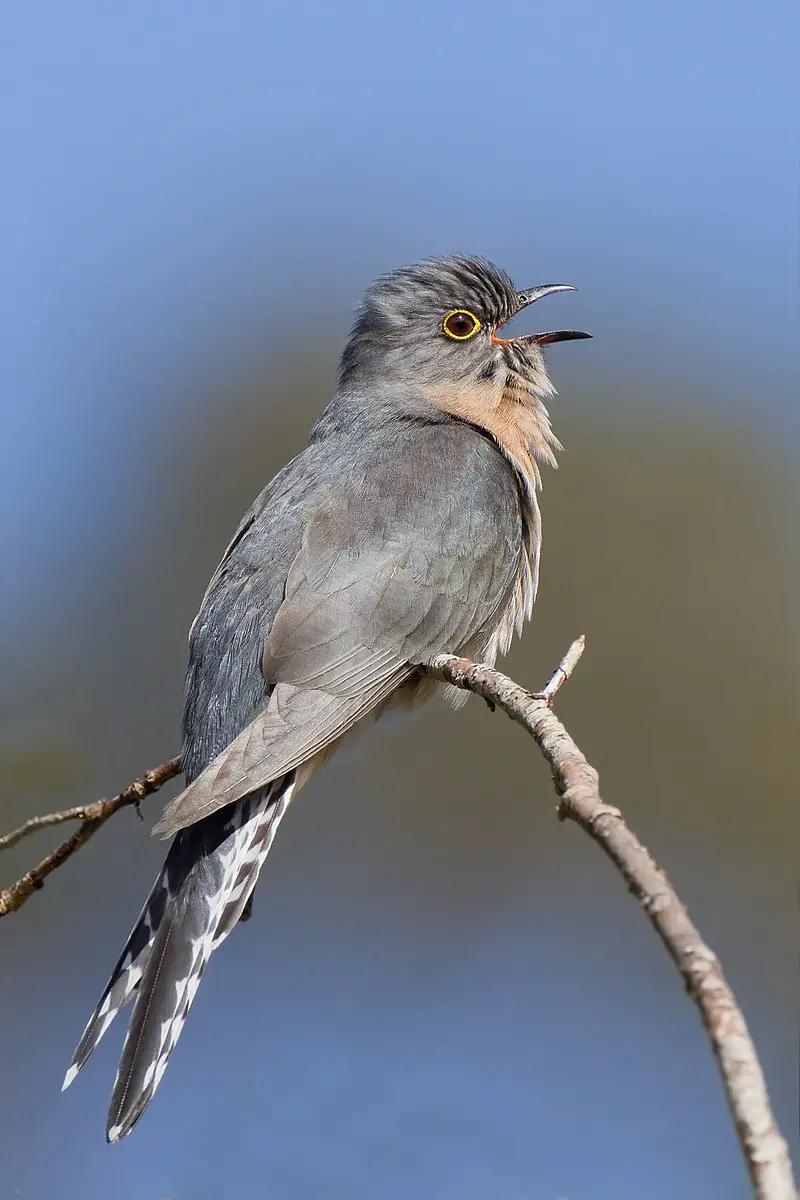
Cuckoos are fascinating birds belonging to the Cuculidae family, which is the only taxon in the order of Cuculiformes.
There are many different species within this family such as common or European cuckoo, roadrunners, koels, malkohas, couas and anis.
Some of these species may even be identified as separate families – Centropodidae and Crotophagidae respectively.
These birds have been known for their unique features such as loud calls heard consistently during certain times of day and night.
They also exhibit behavior like brood parasitism where they lay eggs in other nests so that their chicks can get more food from host parents than its own.
All these traits make them one-of-a-kind creatures worth admiring.Scientific classification:
| Kingdom | Animalia |
| Phylum | Chordata |
| Class | Aves |
| Clade | Otidimorphae |
| Order | Cuculiformes Wagler, 1830 |
| Family | Cuculidae Leach, 1820 |
Also Featured In: Birds of Sweden, Birds You’ll Find in Moldova
4. Woodpeckers
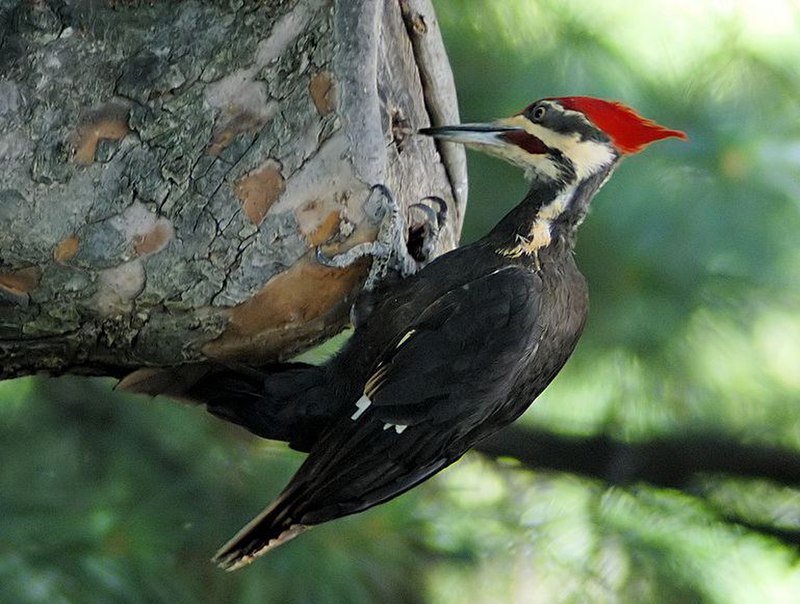
Woodpeckers are an incredibly diverse bird species, found all over the world except for Australia, New Guinea, New Zealand, Madagascar and the extreme polar regions.
They live in a variety of habitats including forests and woodlands but also rocky hillsides and deserts with no trees.
Their beaks are adapted to pecking at tree bark to find food such as insects or larvae hidden beneath it while they use their long tongues to catch them from deep inside crevices.
Woodpeckers have tough skulls that protect their brains from impact when they bang into things during drumming – a behaviour used by males for territorial signalling and reproduction purposes which is done using strong rapid beats against hollow objects like dead branches or metal poles.Scientific classification:
| Kingdom | Animalia |
| Phylum | Chordata |
| Class | Aves |
| Order | Piciformes |
| Infraorder | Picides |
| Family | Picidae Leach, 1820 |
Also Featured In: Birds for Your Home Garden, Most Common Winter Birds
5. Sandpiper
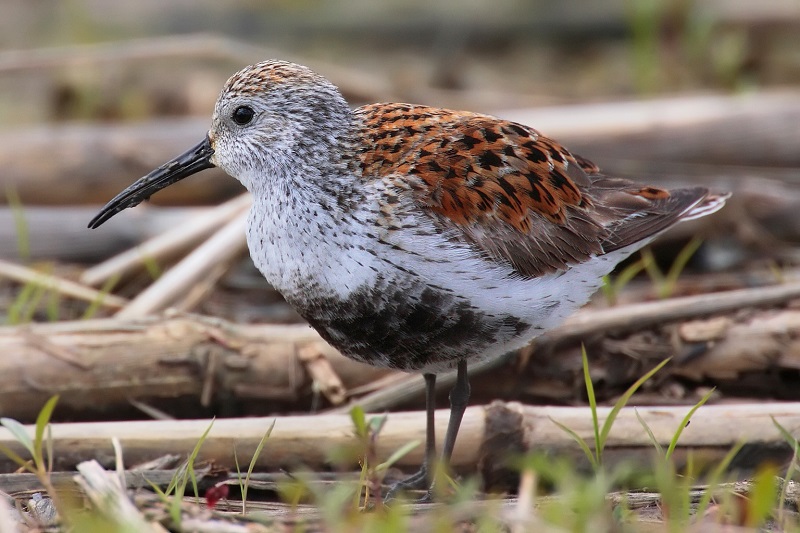
The Sandpiper is a small shorebird that can be found in many parts of the world. It has long, slim legs and webbed feet which help it to navigate through shallow waters while foraging for food.
Its upper body is mostly brown with some white markings on its wings and tail feathers. The underside of the bird is usually grey or light-brown in coloration while they have yellowish bills and black eyes.
They are known to feed on aquatic insects, crustaceans, fish eggs, worms as well as other invertebrates from wetlands across the globe.
These birds migrate long distances during winter months when their preferred habitats freeze over making them incredibly hardy creatures able to withstand harsh conditions out at sea or in open grasslands alike.
6. Herons
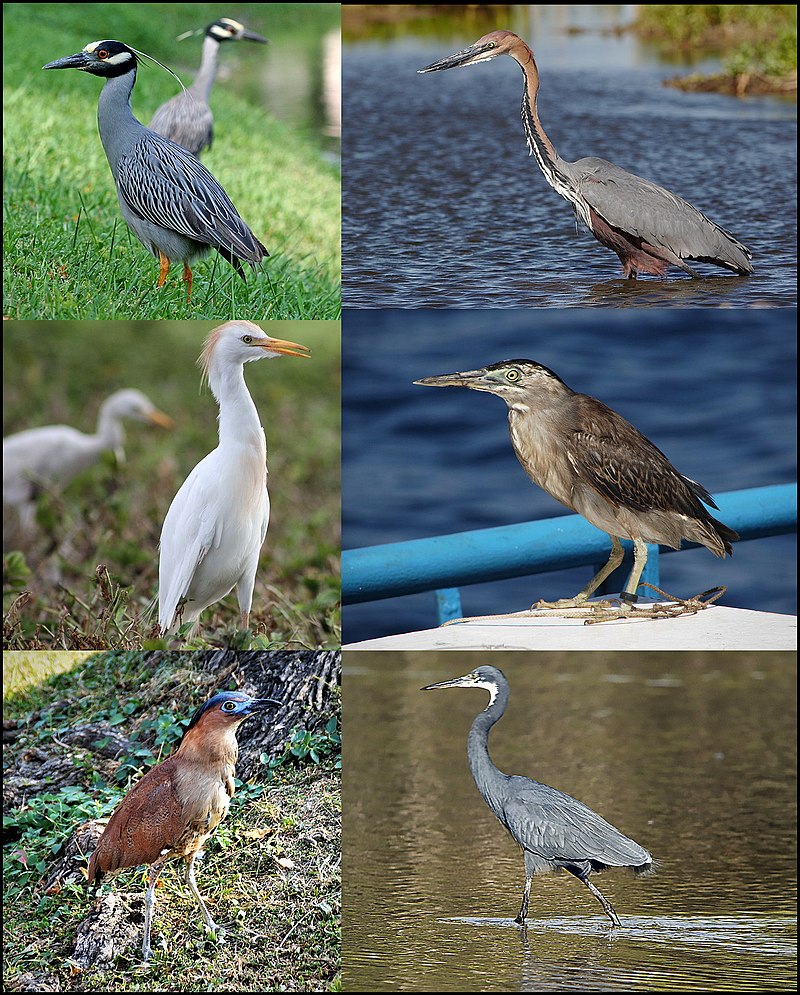
Herons are graceful and elegant birds belonging to the family Ardeidae, with 72 distinct species.
They have long legs and necks that are well-adapted for wading in shallow water like streams or ponds.
Herons can be found near freshwaters as well as along coastal areas worldwide.
Some of these species may also be referred to as egrets, bitterns or zigzag heron/bittern because they belong to certain genera such as Botaurus and Ixobrychus respectively.
These birds stand tall when searching for food by standing still in a shallow body of water while waiting patiently until prey appears before quickly capturing it with their sharp bills.Scientific classification:
| Kingdom | Animalia |
| Phylum | Chordata |
| Class | Aves |
| Order | Pelecaniformes |
| Suborder | Ardei |
| Family | Ardeidae Leach, 1820 |
Also Featured In: Water Birds Live around Us, Famous Paintings Birds
7. White-Bellied Sea Eagle
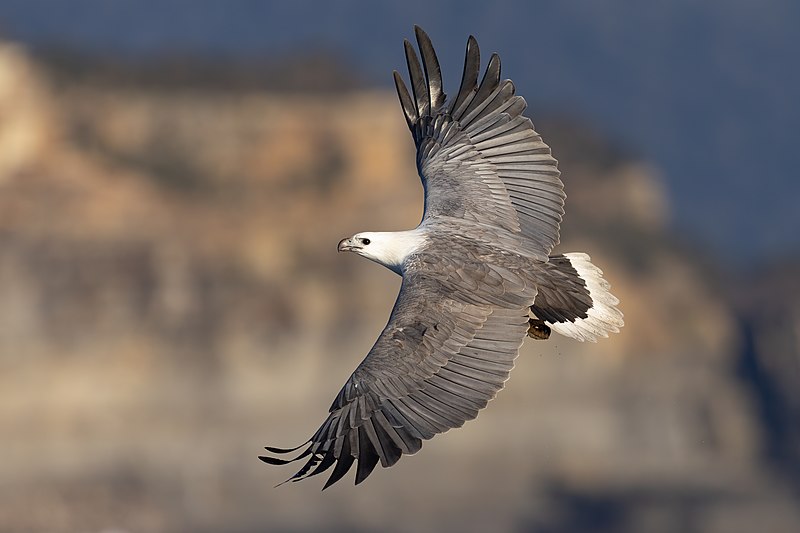
The White-bellied sea eagle is an impressive large bird of prey that belongs to the Accipitridae family.
It was first described by Johann Friedrich Gmelin in 1788 and it is closely related to Sanford’s sea eagle found in the Solomon Islands.
The adult white-bellied sea eagles have a stunning appearance with their white heads, dark brown bodies, and long wings which span up to 1.8 meters across.
They can be seen soaring above coastal areas searching for fish, reptiles or small birds as they hunt for food.
These majestic creatures are also known for being incredibly vocal when nesting – making loud cackling noises at dawn and dusk near riverside forests.Scientific classification:
| Kingdom | Animalia |
| Phylum | Chordata |
| Class | Aves |
| Order | Accipitriformes |
| Family | Accipitridae |
| Genus | Haliaeetus |
| Species | H. leucogaster |
Also Featured In: South Australian Birds, Birds of Tasmania
8. Coppersmith Barbet
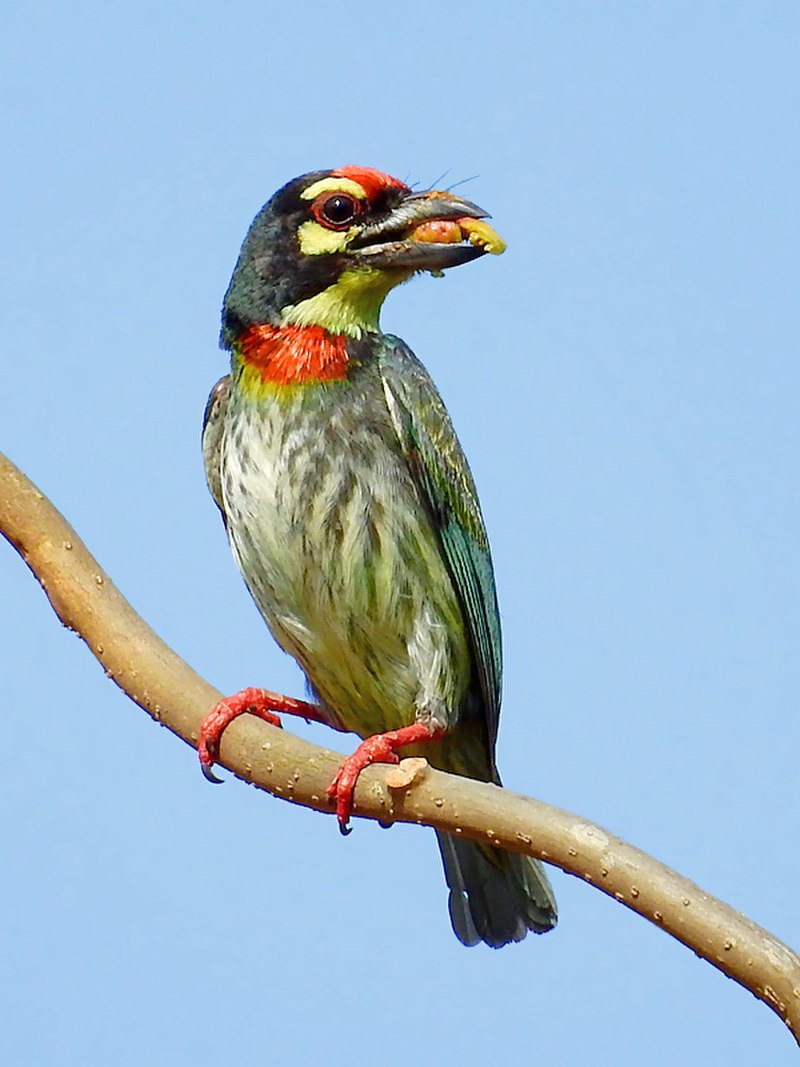
The Coppersmith barbet is an attractive Asian bird, easily recognizable by its bright crimson forehead and throat.
It has a call that sounds like a coppersmith striking metal with a hammer – hence its name.
These birds are found in the Indian subcontinent and parts of Southeast Asia where they build their nests inside trees, carving out holes for themselves.
They can often be seen perched high up on trees or wires during the day as they feed on fruit from nearby branches.
The vibrant colors of these birds make them stand out amongst other species in their habitat.Scientific classification:
| Kingdom | Animalia |
| Phylum | Chordata |
| Class | Aves |
| Order | Piciformes |
| Family | Megalaimidae |
| Genus | Psilopogon |
| Species | P. haemacephalus |
Also Featured In: Birds That Live in the Jungle, Birds of Goa
9. Indian Pond Heron
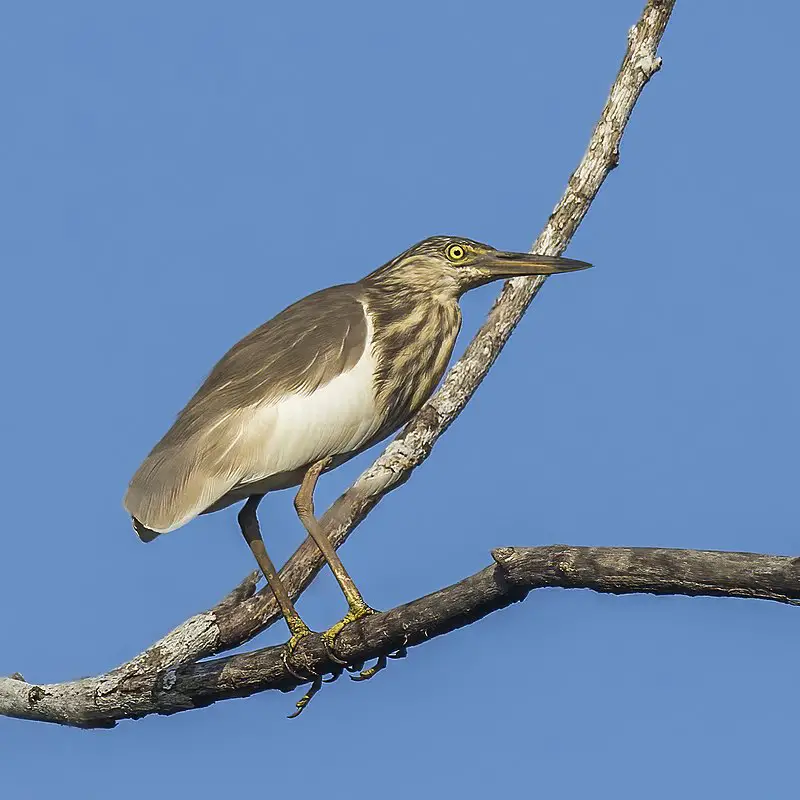
The Indian Pond Heron, also called Paddybird is a small heron found in the Old World. It breeds from southern Iran to India, Burma and Sri Lanka and can be seen near waterbodies or even around human habitations.
These birds are easily recognisable when they take off as their wings make a loud whistling sound due to its long flight feathers which are greyish-brown with white patches on them.
They feed mainly on fish but will eat other aquatic creatures such as frogs and insects too.
During breeding season they construct nests made of reeds close to water bodies where they lay 3–5 eggs at once.
The female incubates the eggs for about 19 days after which both parents share duties of feeding chicks until juveniles become independent enough to fly away.Scientific classification:
| Kingdom | Animalia |
| Phylum | Chordata |
| Class | Aves |
| Order | Pelecaniformes |
| Family | Ardeidae |
| Genus | Ardeola |
| Species | A. grayii |
10. White-Throated Kingfisher
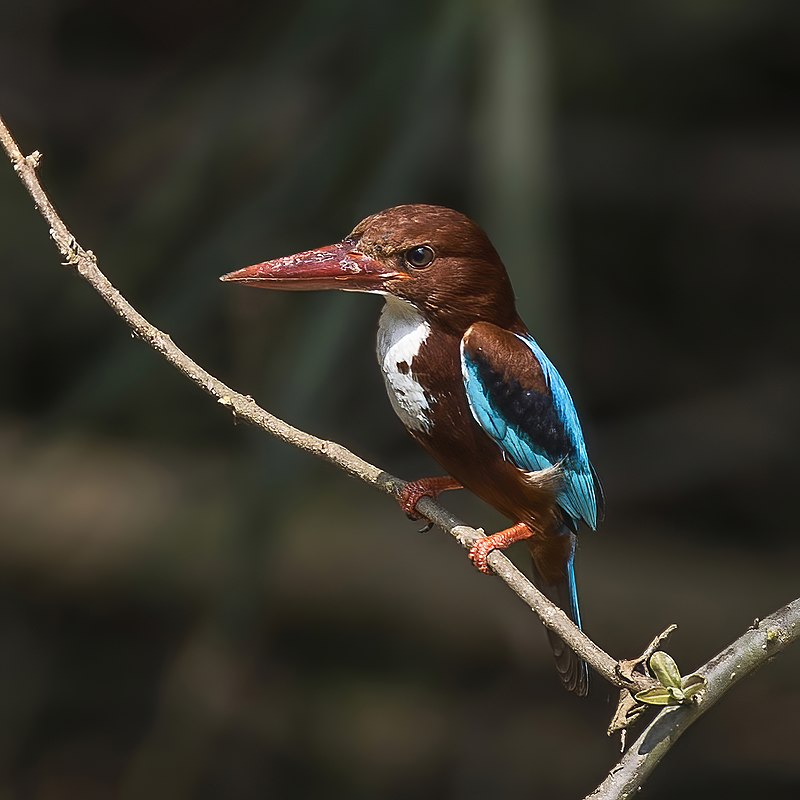
The White-throated Kingfisher is a beautiful bird with bright colors and distinct features. Its back, wings and tail are a deep blue while the head, breast, throat and belly are white.
It has two black stripes across its eyes which contrast nicely against its orange beak and feet.
These birds can often be found perching on tree branches or hovering over creeks in search of food like fish or small insects such as grasshoppers or crickets.
They use their sharp bill to pluck prey from water surfaces then swallow them whole after making adjustments for size by beating it against rocks if necessary.
The White-throated Kingfisher breeds during monsoon season when rainfall increases levels in rivers leading to an abundance of aquatic life that these birds love so much.Scientific classification:
| Kingdom | Animalia |
| Phylum | Chordata |
| Class | Aves |
| Order | Coraciiformes |
| Family | Alcedinidae |
| Subfamily | Halcyoninae |
| Genus | Halcyon |
| Species | H. smyrnensis |
11. Darters
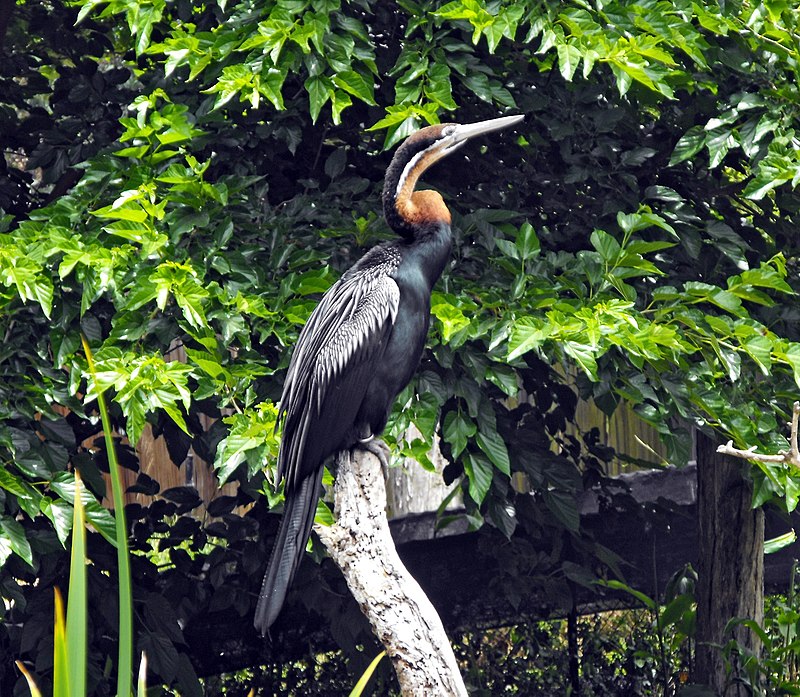
Darters are tropical waterbirds from the family Anhingidae, which includes four species. Three of these species are common and found in multiple locations while one is rarer and classified as near-threatened by IUCN.
Their most notable feature is their long neck which they use to dive into shallow waters for prey such as fish or frogs.
They have a slim body with large wings allowing them to soar high in the sky at great speeds making it difficult for predators to catch them during flight.
Darters also make regular visits to land where they bask in the sun on tree branches or rocky outcroppings.
These birds can be easily identified by their dark feathers, yellowish eyes, and orangey beak – all features that help distinguish them from other birds of similar size and coloration.Scientific classification:
| Kingdom | Animalia |
| Phylum | Chordata |
| Class | Aves |
| Order | Suliformes |
| Family | Anhingidae Reichenbach, 1849[1] |
| Genus | Anhinga Brisson, 1760 |
Also Featured In: Common Birds in Kerala, Birds that Live in Tamil Nadu
12. Ducks
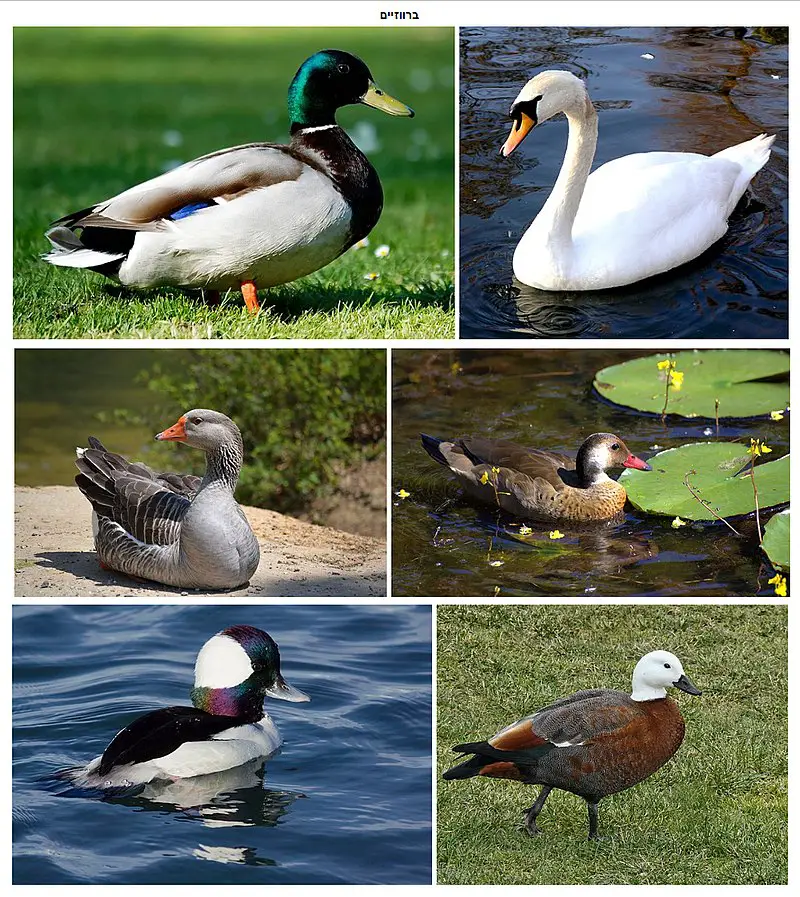
Ducks are water birds belonging to the family of Anatidae. They have a worldwide distribution except Antarctica and are highly adapted for swimming, floating on water surface or in shallow depths.
Ducks come in various sizes ranging from small teals to large swans with around 174 species found across 43 genera.
Their feathers make them waterproof enabling ducks to stay afloat even in stormy waters while their webbed feet allow them to swim gracefully underwater.
Ducks usually feed by filtering food items such as insects, molluscs and crustaceans through their bills but some also graze on land vegetation like grasses & grains depending upon availability of resources at different locations they inhabit.Scientific classification:
| Kingdom | Animalia |
| Phylum | Chordata |
| Class | Aves |
| Order | Anseriformes |
| Suborder | Anseres |
| Superfamily | Anatoidea |
| Family | Anatidae Leach, 1820 |
Also Featured In: Turkey Birds You Should Know, Birds that Live in Croatia
13. Phasianidae
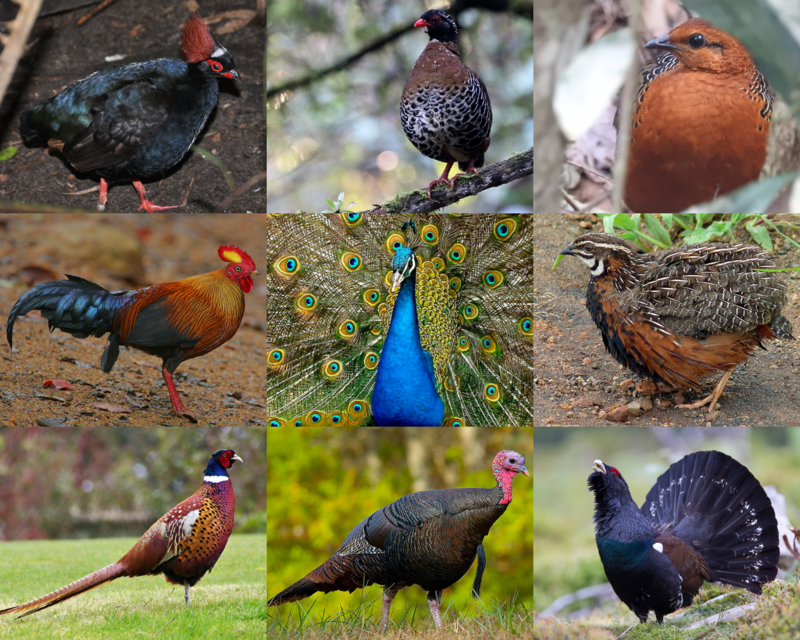
The Phasianidae family of birds is one that contains many popular gamebirds, with a total of 185 species divided across 54 genera.
These heavy ground-living birds include pheasants, partridges, junglefowl, chickens, and turkeys among others like Old World quail and peafowl.
This large family was formerly split into two subfamilies known as the Phasianinae and Perdicinae but this classification has since been changed to reflect more current scientific findings on them.
All these different types of birds have certain things in common such as their strong legs for scratching through leaves or soil looking for food items including insects, seeds, and other vegetation which makes up most of their diet.
They also all tend to be quite colorful in order to attract mates during breeding season when males will often display vibrant feathers or do dances around females in an attempt at courtship ritual displays.
The majority are monogamous creatures too although some may form short-term pair bonds before going off alone again once mating has taken place – either way.
There tends to be very little parental care given by adults after eggs have hatched so chicks need to fend for themselves right away.Scientific classification:
| Kingdom | Animalia |
| Phylum | Chordata |
| Class | Aves |
| Order | Galliformes |
| Superfamily | Phasianoidea |
| Family | Phasianidae Horsfield, 1821 |
14. Piciformes
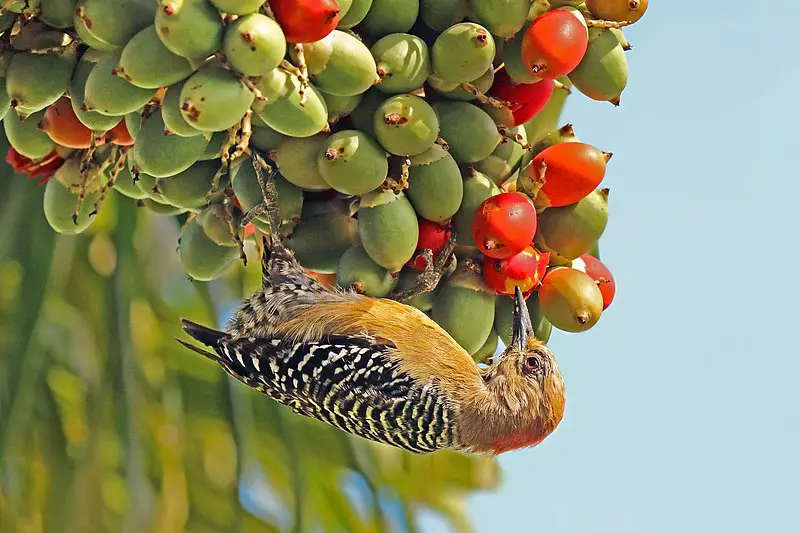
Piciformes are a diverse order of birds that includes the woodpeckers, barbets and toucans. They can be found in most regions around the world, with some species being migratory.
Generally they feed on insects, but fruit forms a large part of their diet for certain families such as barbets and toucans.
The Piciformes consist of 71 living genera containing over 450 individual species; almost half belonging to one family – the Picidae (woodpeckers).
As arboreal birds, many have adapted well to urban environments too which has helped them survive despite deforestation and habitat loss elsewhere.Scientific classification:
| Kingdom | Animalia |
| Phylum | Chordata |
| Class | Aves |
| Clade | Picodynastornithes |
| Order | Piciformes Meyer & Wolf, 1810 |
15. Plovers

Plovers are a family of around 64-68 species of ground-dwelling birds, commonly found in open country such as fields, meadows and tundras.
They have short bills with webbed feet to help them forage through mud or shallow water.
Plover plumage is usually mottled brown though some species may have brighter colors on the head and wings.
These birds feed mainly on insects but can also eat small crustaceans and worms.
Plovers breed during springtime when they dig holes in sandy or pebbled beaches to lay their eggs which hatch after about 3 weeks incubation period.
They use distraction display behaviour by pretending an injury to the predators away from their nests if needed for protecting their young ones.Scientific classification:
| Kingdom | Animalia |
| Phylum | Chordata |
| Class | Aves |
| Order | Charadriiformes |
| Family | Charadriidae Leach, 1820 |
16. True Owl
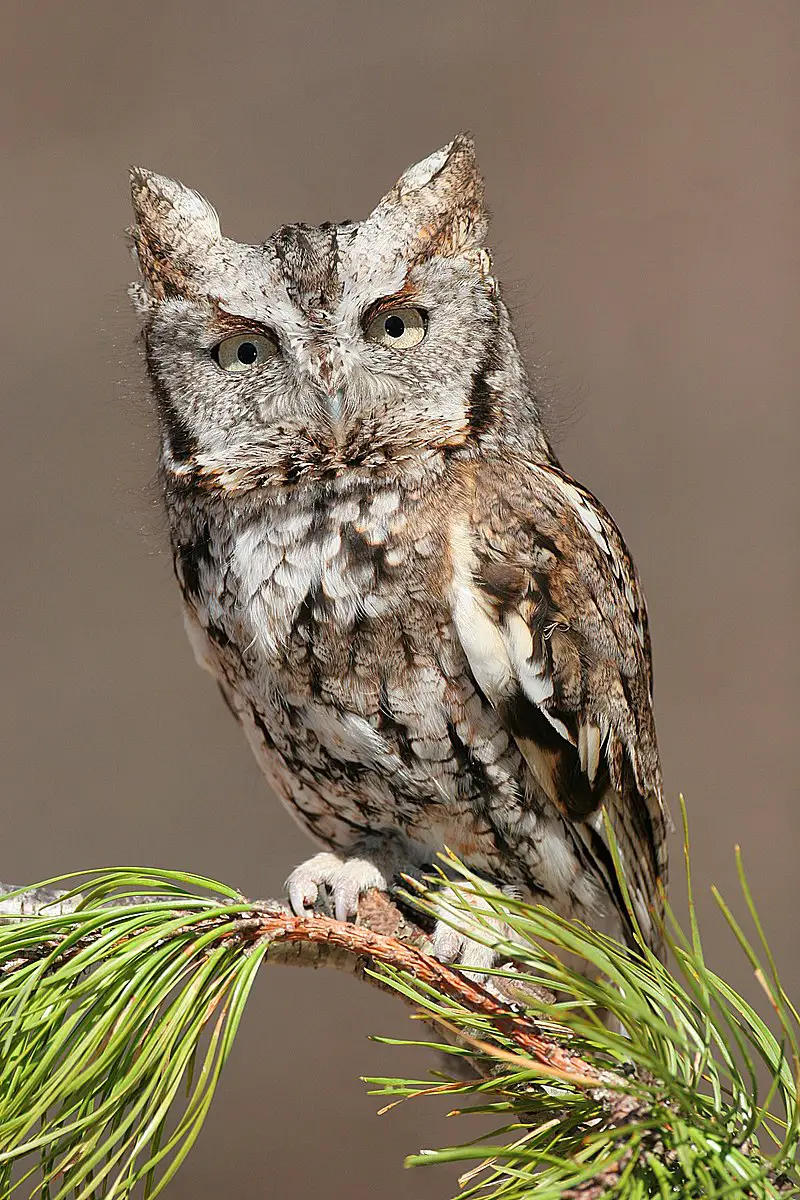
Owls are one of the two main families of owls, with Strigidae being the true owl family. With 230 species and 24 genera, this large bird family is found all around the world except for Antarctica.
Owls vary greatly in size and shape, but they typically have a round face with forward-facing eyes and a hooked bill to help them catch their prey.
They also possess asymmetrical ears that allow them to detect even faint sounds from great distances making them formidable predators at night.
Although solitary by nature, some species can be quite vocal while others may remain silent during daylight hours until sunset when they become active again looking for food under cover of darkness.Scientific classification:
| Kingdom | Animalia |
| Phylum | Chordata |
| Class | Aves |
| Order | Strigiformes |
| Family | Strigidae Leach, 1820 |
Also Featured In: Birds You’ll Find in Night, Birds of Taiga
17. Accipitridae
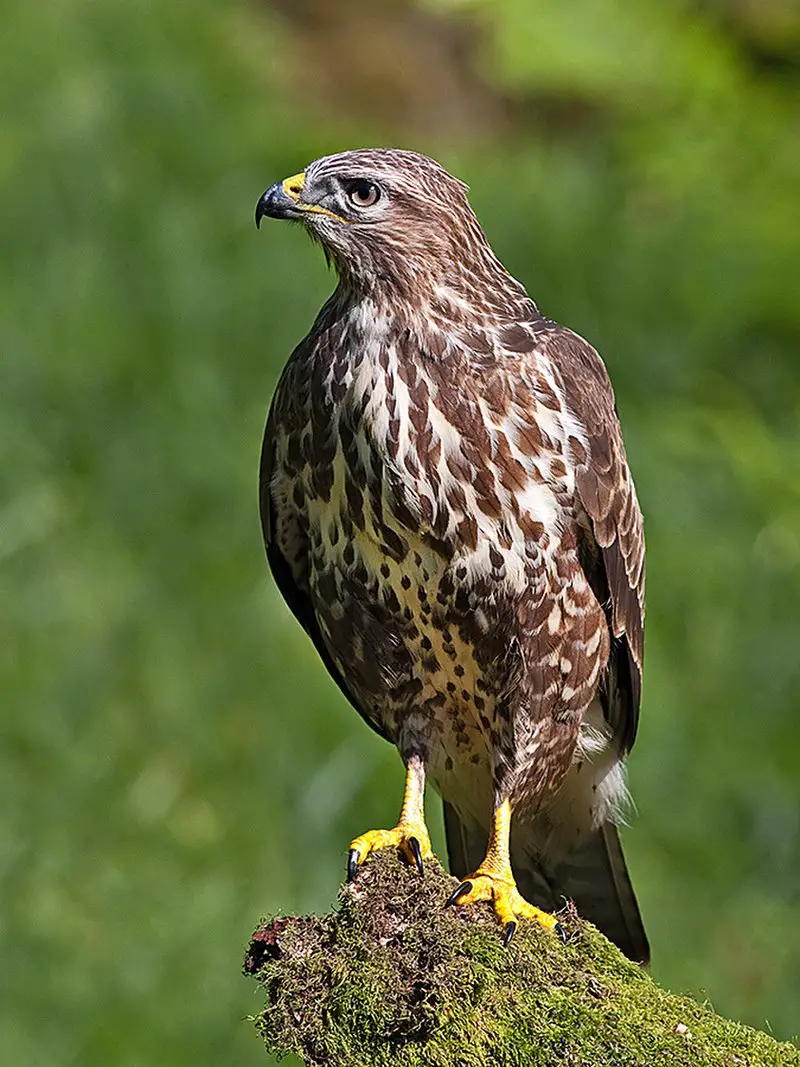
Accipitridae birds are a diverse family of raptors ranging in size from small to large. They have powerful hooked beaks which they use for hunting and tearing apart their prey, such as insects, medium-sized mammals and carrion.
Some species even feed on fruit. These birds can be found all over the world, making them an incredibly successful group of predators.
Accipitridae are adaptable hunters with keen eyesight that helps them spot potential meals from far away distances.
Their sharp talons assist them in grasping onto their victims while feeding or defending themselves against enemies.
Not only do these avian creatures provide us with visual beauty but also help keep our ecosystems healthy by keeping pest populations under control.Scientific classification:
| Kingdom | Animalia |
| Phylum | Chordata |
| Class | Aves |
| Order | Accipitriformes |
| Family | Accipitridae Vieillot, 1816 |
Also Featured In: Italian Birds You Should Know, African Birds
18. Brahminy Kite
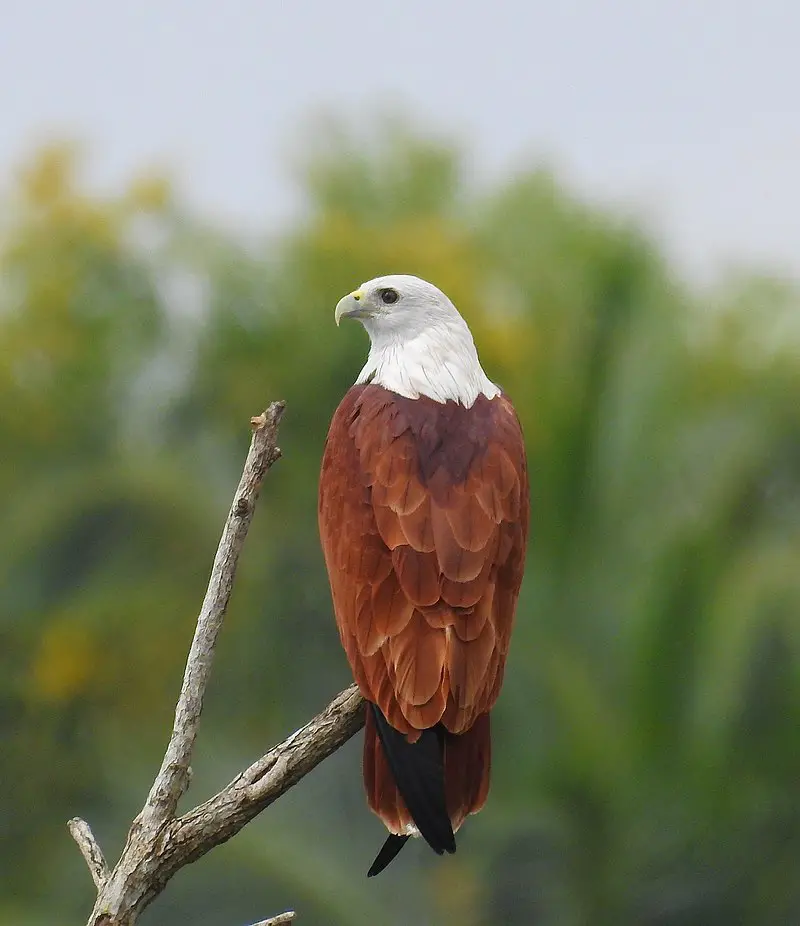
The Brahminy Kite is a majestic bird of prey native to the Indian subcontinent, Southeast Asia and Australia. It was formerly known as the red-backed sea eagle in Australia.
This medium-sized raptor has a distinctive white head with rufous brown feathers covering its body, making it easily recognisable from far away. The wingspan can reach up to 5 feet wide.
Brahminy kites are found mainly on coasts and inland wetlands where they feed mostly on dead fish or carrion left by other animals.
They also hunt for small mammals such as rodents or reptiles like lizards and snakes during dry spells when food sources become scarce.
These birds have adapted well over time and will even scavenge for food near picnic sites or urban areas if need be.
Overall these beautiful creatures are an important part of their local ecosystems which rely heavily upon them for keeping animal populations balanced through natural predation methods instead of manmade ones; this ensures that nature remains healthy so future generations may enjoy it too.Scientific classification:
| Kingdom | Animalia |
| Phylum | Chordata |
| Class | Aves |
| Order | Accipitriformes |
| Family | Accipitridae |
| Genus | Haliastur |
| Species | H. indus |
Also Featured In: Birds that Live around Brisbane, Birds that Charles Darwin Studied
19. Black-Capped Kingfisher
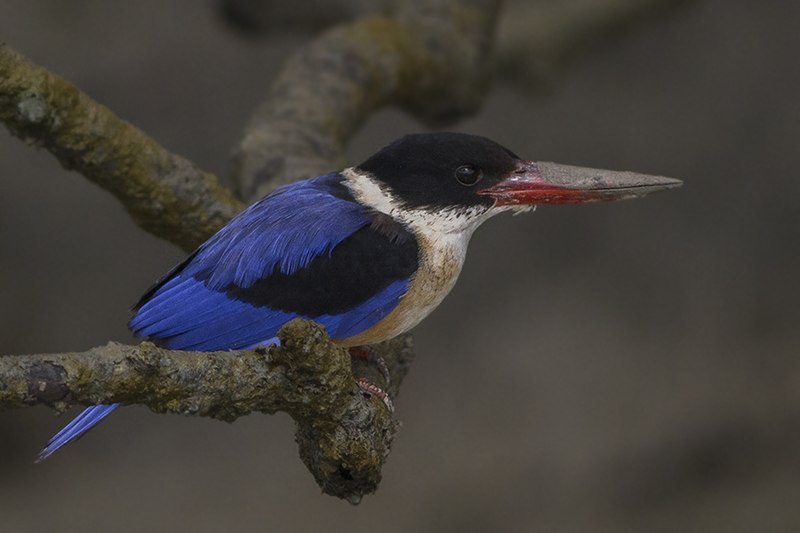
The Black-capped Kingfisher is a beautiful species of tree kingfishers found in tropical Asia from India east to China, Korea and Southeast Asia.
Its striking features include its black cap that contrasts with its bright blue back, wings and tail.
It has white underparts which makes it easily identifiable when perched atop trees or flying above the ground searching for food.
During winter months some northern populations migrate south seeking warmer climates such as Sri Lanka, Thailand, Borneo and Java.
The diet of this bird consists mainly of insects but may also feed on small reptiles like lizards or snakes if available.
They can be seen generally near water bodies where they hunt their prey by diving into the waters from a high perch.Scientific classification:
| Kingdom | Animalia |
| Phylum | Chordata |
| Class | Aves |
| Order | Coraciiformes |
| Family | Alcedinidae |
| Subfamily | Halcyoninae |
| Genus | Halcyon |
| Species | H. pileata |
Also Featured In: Birds that Migrate to Sri Lankan, Most Common Birds of Ko Samui
20. Blue-Eared Kingfisher
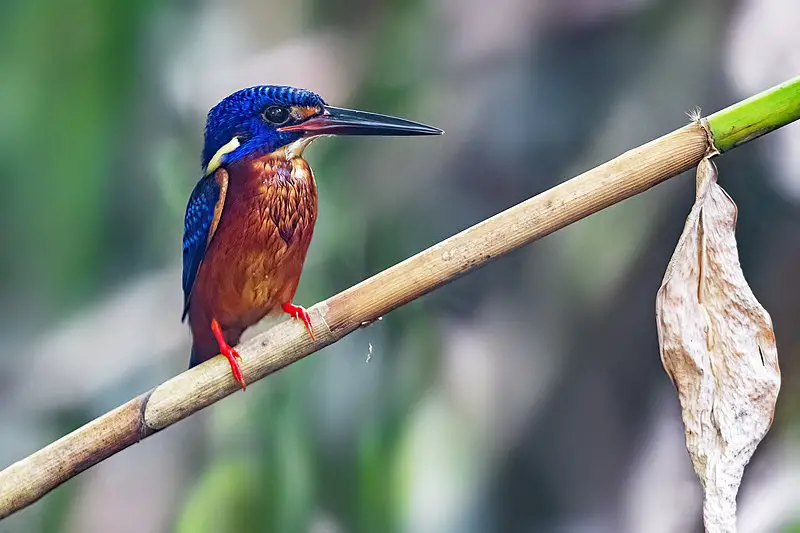
The Blue-eared Kingfisher is a beautiful species of bird found mainly in the dense forests across India and Southeast Asia.
Its distinguishing features include its darker crown, dark rufous underparts, and lack of the typical red ear stripe seen on other kingfishers such as Alcedo atthis which usually inhabit more open environments.
There are different subspecies identified by researchers due to slight variations in size or colouration present within this species.
The Blue-eared Kingfisher feeds mostly on small fish it catches while hunting along slow moving streams near shaded areas that provide plenty of cover from predators.
Not much else is known about these beautiful birds but they remain an important part of their local ecosystems.Scientific classification:
| Kingdom | Animalia |
| Phylum | Chordata |
| Class | Aves |
| Order | Coraciiformes |
| Family | Alcedinidae |
| Subfamily | Alcedininae |
| Genus | Alcedo |
| Species | A. meninting |
Also Featured In: Birds that Commonly Found in Bali, Common Birds that Live in Odisha
21. White-Breasted Waterhen
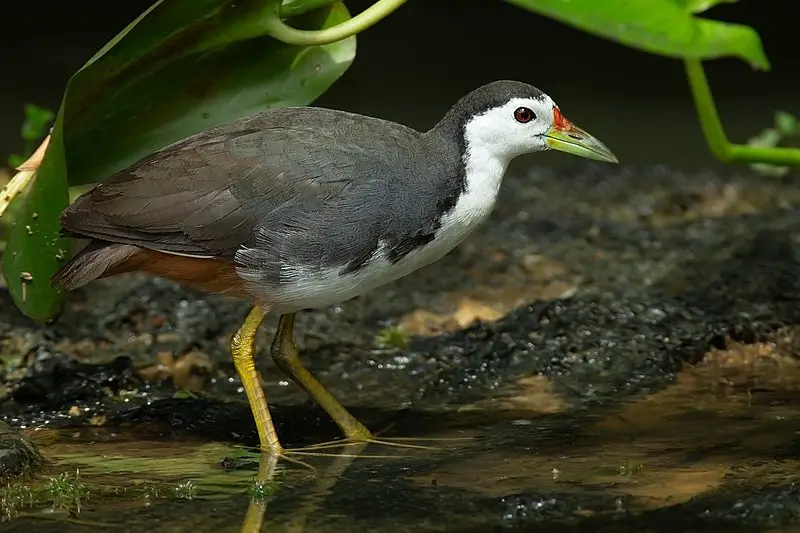
The White-breasted Waterhen is a stunning species of bird from South and Southeast Asia. It has a striking appearance, with its dark slaty plumage contrasted by the clean white of its face, breast and belly.
This bold waterbird can often be seen slowly walking around marshes or even drains near busy roads with its tail held upright in an unmistakable pose.
They are omnivores which feed on both plants and small animals such as insects and invertebrates.
The White-breasted Waterhen plays an important role in their ecosystems as they help to keep it balanced by consuming pests that could potentially cause damage to crops or other plant life if left unchecked.Scientific classification:
| Kingdom | Animalia |
| Phylum | Chordata |
| Class | Aves |
| Order | Gruiformes |
| Family | Rallidae |
| Genus | Amaurornis |
| Species | A. phoenicurus |
Also Featured In: Common Birds in Bangalore, Big Birds that Live in Singapore
22. Asian Green Bee-Eater
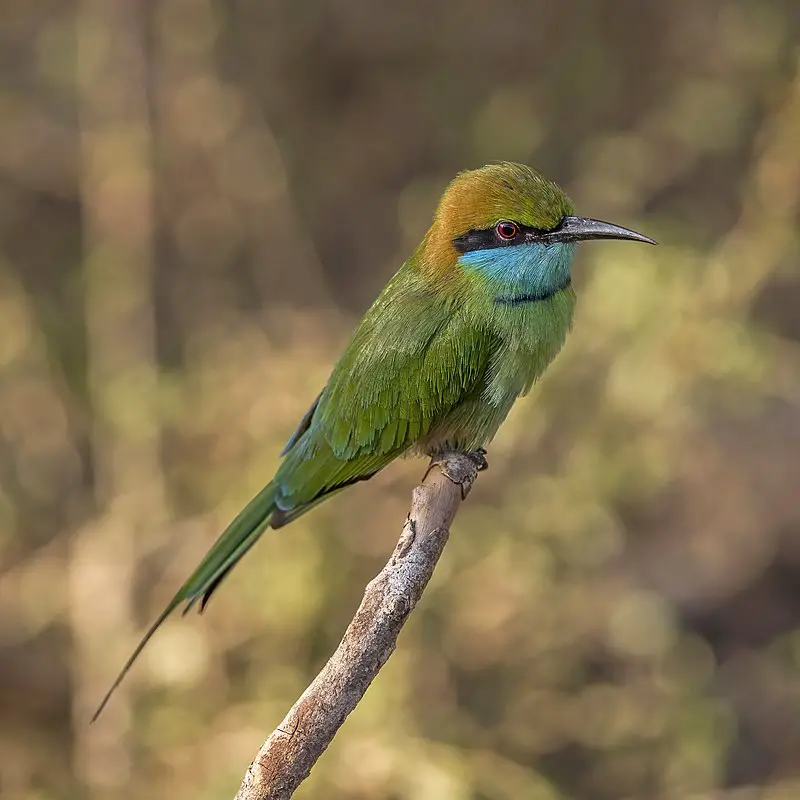
The Asian green bee-eater is a near passerine bird in the bee-eater family. It’s native to parts of Asia, stretching from Iran all the way over to Vietnam.
These birds are resident but tend to migrate seasonally and can also be found in Africa and Arabia.
They have bright green feathers on their upperparts with yellowish underparts, making them easy to spot when they’re flying around looking for insects like bees, wasps and dragonflies.
They usually nest burrows dug into sandy ground or riverbanks where they lay up to five eggs at once.
The Asian green bee-eater is an exciting species that has been popular among ornithologists since its discovery hundreds of years ago.Scientific classification:
| Kingdom | Animalia |
| Phylum | Chordata |
| Class | Aves |
| Order | Coraciiformes |
| Family | Meropidae |
| Genus | Merops |
| Species | M. orientalis |
Also Featured In: Birds You’ll Find in Kanha National Park, Birds of Konkan
23. Masked Finfoot
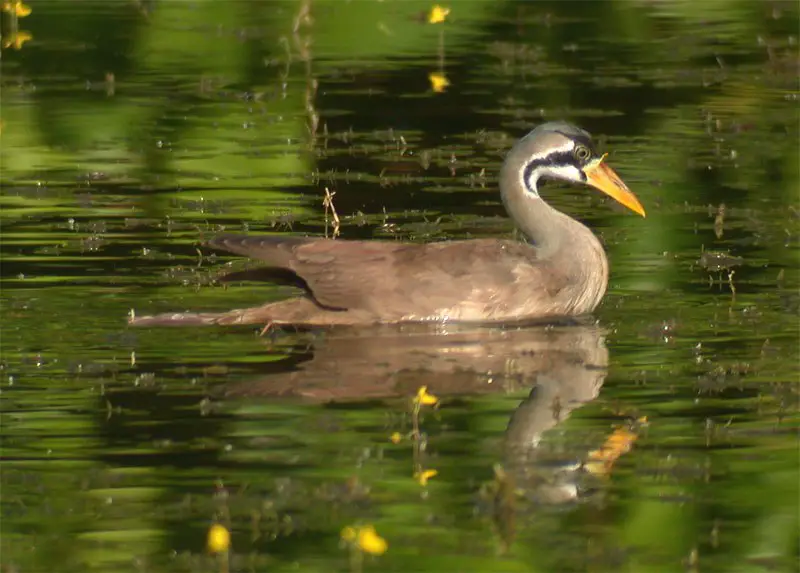
The Masked Finfoot is an endangered bird native to the fresh and brackish wetlands of Eastern India, Indochina, Malaysia and Indonesia.
It belongs to a family whose relationship with other birds remains largely unknown.
This aquatic species has distinct black-and-white plumage that covers its head like a mask while its back and wings are dark green in color.
Its striking red eyes stand out against this otherwise monotone appearance.
The masked finfoot can stay underwater for long periods due to their laterally compressed bodies which help them maneuver through water quickly and efficiently.
They feed mainly on fish but also consume frogs, crustaceans, mollusks, insects and even some plant material from time to time providing valuable ecosystem services such as controlling insect populations near riverside habitatsScientific classification:
| Kingdom | Animalia |
| Phylum | Chordata |
| Class | Aves |
| Order | Gruiformes |
| Family | Heliornithidae |
| Genus | Heliopais Sharpe, 1893 |
| Species | H. personatus |
24. Black Francolin
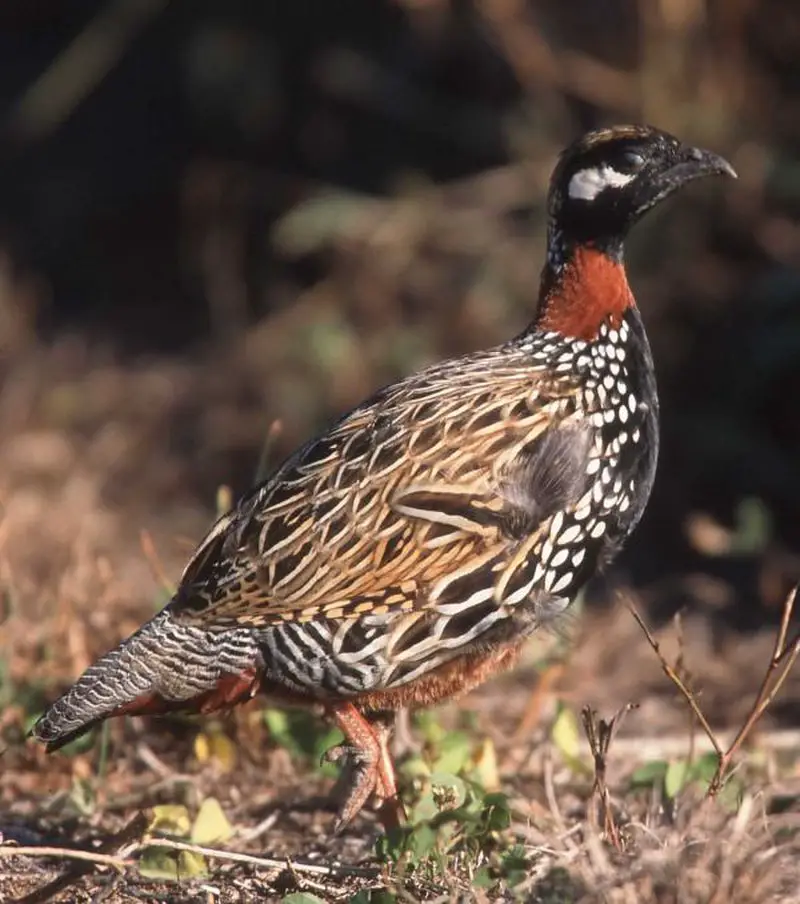
Black francolin is a species of gamebird belonging to the pheasant family. It was once known as black partridge and is now declared as state bird of Haryana, India.
The adult males are generally about 33-36 cm in length with an average weight of 453 gm.
They have glossy black plumage with white spotting on their wings and body parts along with barring patterns on tail feathers which makes them look attractive.
Their call sounds like ‘kattar kattar’ continuously repeated at regular intervals throughout the day during breeding season from April – June when they become highly vocal for mating purpose.
These birds can be found in open grasslands, scrub forests or agricultural fields where plenty of food (mainly insects) is available for survival & reproduction purposes making it one of the most common avifauna across its range countries such as Pakistan, Afghanistan & Nepal etc..Scientific classification:
| Kingdom | Animalia |
| Phylum | Chordata |
| Class | Aves |
| Order | Galliformes |
| Family | Phasianidae |
| Genus | Francolinus |
| Species | F. francolinus |
Also Featured In: Armenian Birds You Should Know, Birds that Live in Rajasthan
25. Brown Wood Owl
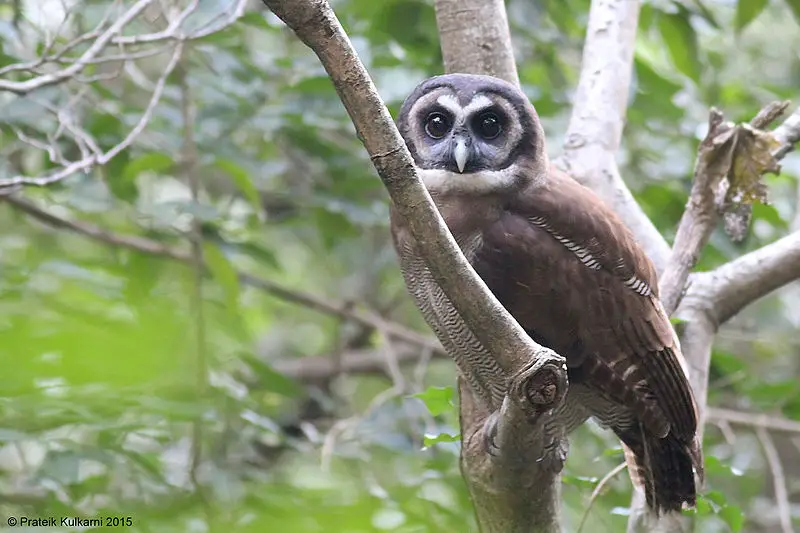
The Brown Wood Owl is a beautiful bird native to parts of Asia. It measures 45-57 cm in length and has unicolored upperparts that vary from light brown to dark gray, while its underparts are barred with pale streaks.
Its head features large yellow eyes and prominent ear tufts which give it an impressive appearance. This species is part of the typical owl family (Strigidae) and belongs to the genus Strix.
The habitat of this species includes dense forests, woodlands, mangroves as well as plantations across India, Bangladesh Sri Lanka Indonesia Taiwan and south China where they breed all year round.
An interesting fact about these owls is that their diet consists mainly of rodents such as rats or mice making them important for controlling rodent populations in agricultural areas.Scientific classification:
| Kingdom | Animalia |
| Phylum | Chordata |
| Class | Aves |
| Order | Strigiformes |
| Family | Strigidae |
| Genus | Strix |
| Species | S. leptogrammica |
Also Featured In: Most Common Taiwan Birds,
26. Brown Fish Owl
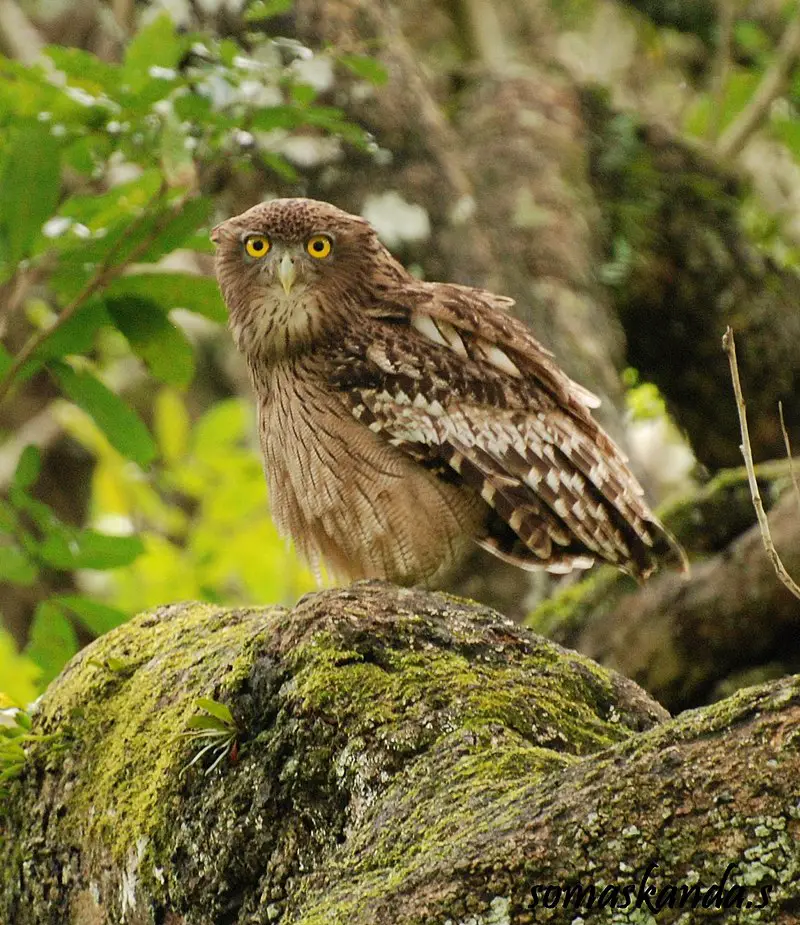
The Brown Fish Owl is a species of owl found in Turkey, South and Southeast Asia. It inhabits forests and wooded wetlands with its wide distribution leading to it being categorized as least concern on the IUCN Red List.
Of all four living fish owl species, this one is the most abundant, widespread and studied. Its diet consists mainly of fish but also small mammals or reptiles when available.
They usually hunt from perches near water sources waiting for their prey before swooping down to capture them using powerful talons between dusk until dawn.
These birds are monogamous with pairs staying together throughout the year while raising their young which hatch after 30 days of incubation by both parents in tree hollows or rock crevices close to streams or lakesides where they can easily find food for themselves and their offspringScientific classification:
| Kingdom | Animalia |
| Phylum | Chordata |
| Class | Aves |
| Order | Strigiformes |
| Family | Strigidae |
| Genus | Ketupa |
| Species | K. zeylonensis |
Also Featured In: Common Birds of Chhattisgarh,
27. Vernal Hanging Parrot
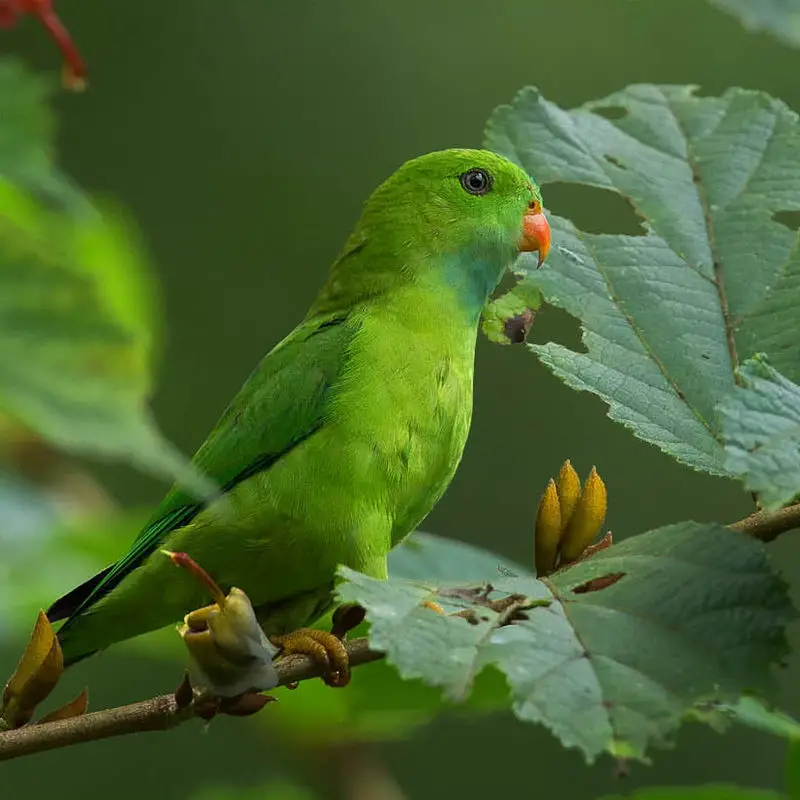
The Vernal hanging parrot is a small, colourful bird native to the Indian subcontinent and parts of Southeast Asia. It has bright green feathers with black edging above its wings and tail, while its chest and belly are yellow-green in colour.
They feed mainly on fruit, seeds, buds and blossoms which they find by frequenting banyan trees for their fruits as well as plantain trees for nectar from flowers.
Although it typically stays within one area throughout the year there have been occasions where this species will move around due to changes in food availability or seasonality.
As such these birds can be found across various habitats including forests, woodlands and urban areas too.Scientific classification:
| Kingdom | Animalia |
| Phylum | Chordata |
| Class | Aves |
| Order | Psittaciformes |
| Family | Psittaculidae |
| Genus | Loriculus |
| Species | L. vernalis |
Also Featured In: Birds of Karnataka, Pet Birds that Live in India
28. Dark-Necked Tailorbird
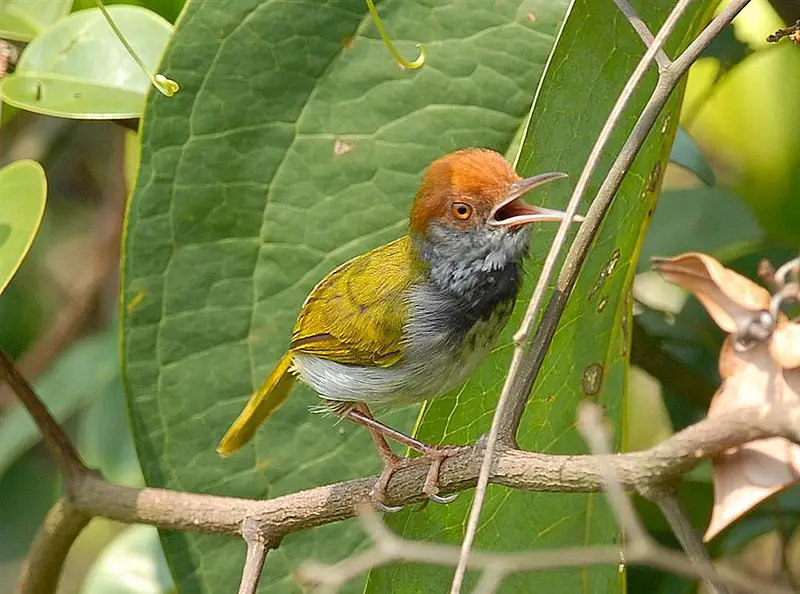
The Dark-necked Tailorbird is a small songbird species that belongs to the Cisticolidae family. It can be found in Bangladesh, Northeast India and Southeast Asia, where it inhabits subtropical or tropical moist lowland forests as well as mangrove forests.
This bird has an olive-brown upper body with dark streaks on its wings and tail while its underside is yellowish white with grey flanks.
The head of this species has distinct black stripes running from behind the eye down onto neck which gives it its name – “Dark-Necked”.
Its call sound like ‘dzeet’ and they are usually heard during morning hours when these birds sing in pairs or groups perched high up in trees.Scientific classification:
| Kingdom | Animalia |
| Phylum | Chordata |
| Class | Aves |
| Order | Passeriformes |
| Family | Cisticolidae |
| Genus | Orthotomus |
| Species | O. atrogularis |
Also Featured In: Birds that Live in Kuala Lumpur, Birds that Found in Sumatra
29. Orange-Bellied Flowerpecker
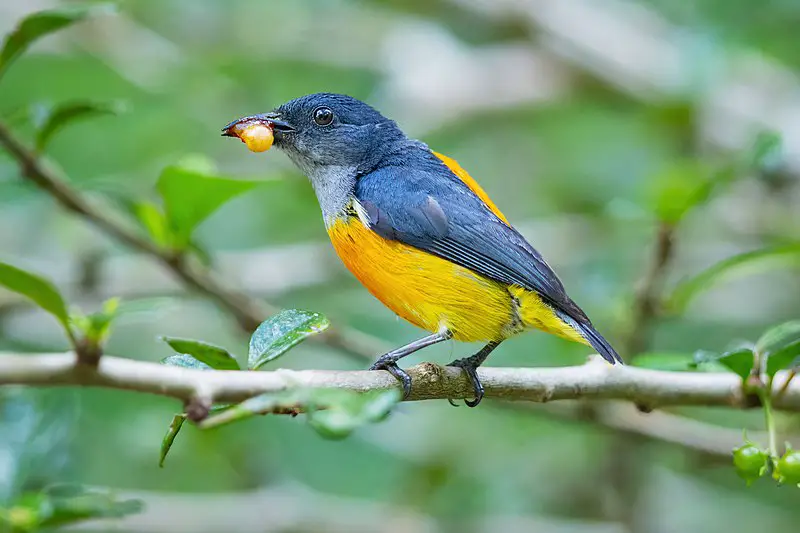
The orange-bellied flowerpecker is a small bird found in countries such as Bangladesh, Brunei, India and Thailand. It inhabits lowland forests, mangrove forests and montane forests.
Males of this species are quite distinctive with their bright orange bellies contrasting against the black head with white markings around the eyes.
They have green wings that feature yellow edging on the tips of their primaries and secondaries.
Their bill is short but stout for its size making it ideal for catching insects from branches or tree trunks during feeding sessions.
The female differs slightly in coloration having an olive crown instead of black one which makes them easier to identify when observed together within flocks or pairs .Scientific classification:
| Kingdom | Animalia |
| Phylum | Chordata |
| Class | Aves |
| Order | Passeriformes |
| Family | Dicaeidae |
| Genus | Dicaeum |
| Species | D. trigonostigma |
Also Featured In: Most Common Birds in Negros,
30. Blue Pitta
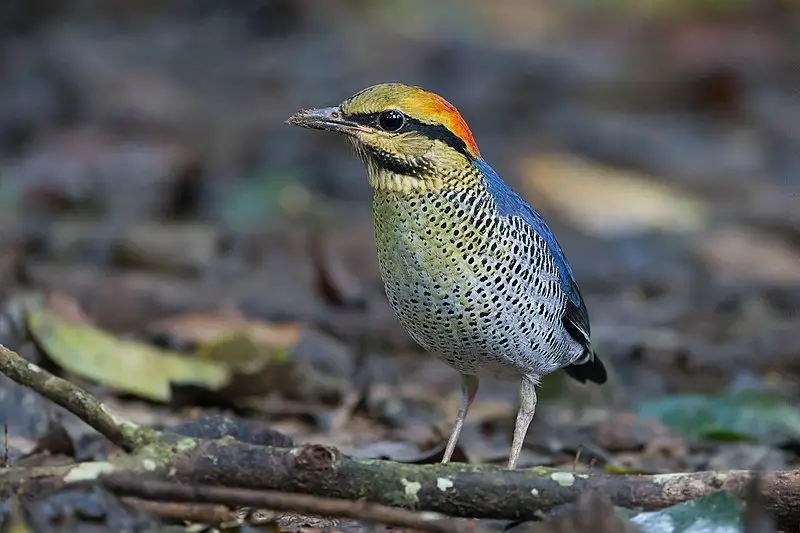
The Blue Pitta is a vibrant and beautiful bird that belongs to the family of Pittidae. It can be found in moist forests, dry forests, and across the northeastern Indian subcontinent, southern China, and Indochina.
They are generally solitary birds with stocky bodies characterized by their long tail feathers which contrast against their bright blue plumage.
The diet of these birds consists mainly of insects and other small invertebrates which they forage from the ground or low-lying trees.
Overall this species has adapted well to its environment though it remains relatively inconspicuous due to its shyness towards humansScientific classification:
| Kingdom | Animalia |
| Phylum | Chordata |
| Class | Aves |
| Order | Passeriformes |
| Family | Pittidae |
| Genus | Hydrornis |
| Species | H. cyaneus |
31. Blue-Naped Pitta
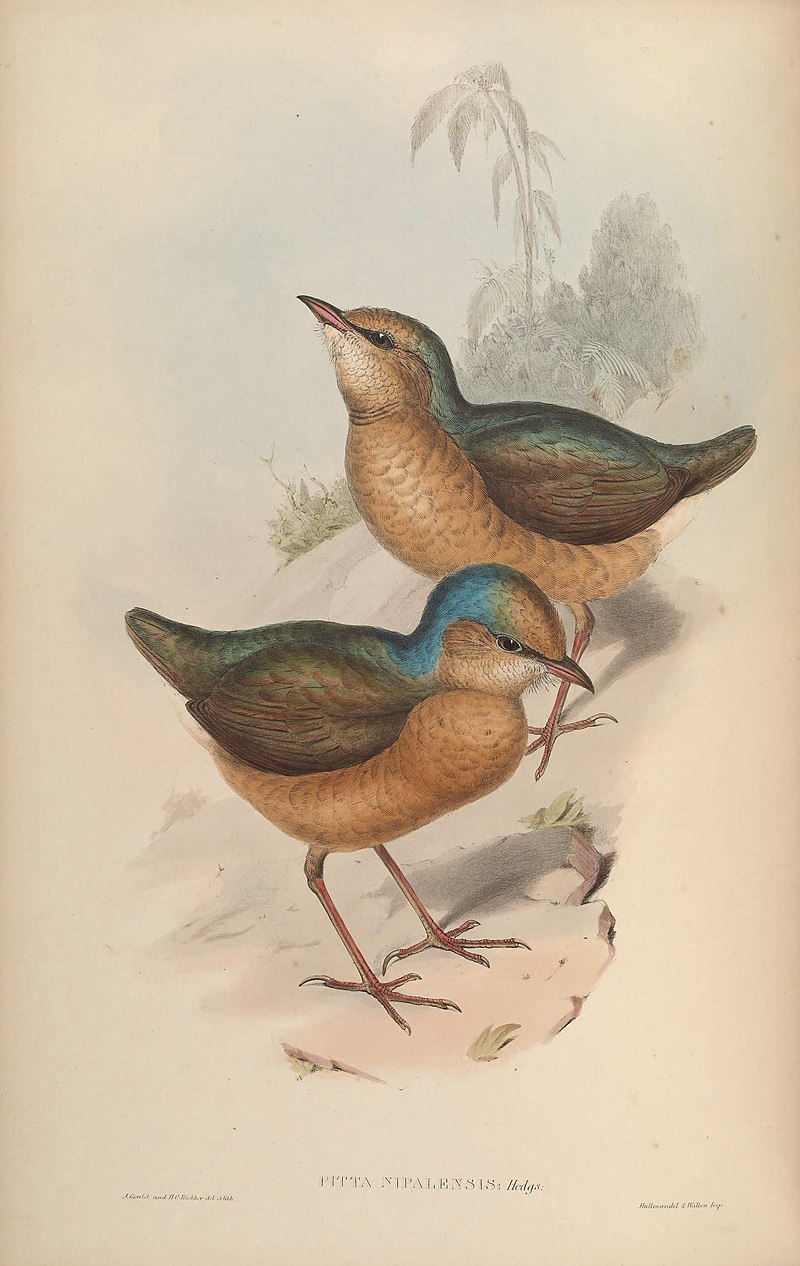
The Blue-naped Pitta is a beautiful species of bird belonging to the family Pittidae. It stands out for its bright colors, including blue and green above, with reddish-yellow coloring below.
The nape and hindneck are particularly striking in their vibrant blue hue while the tail is brown mixed with some green.
Male and female birds look similar but there’s one key difference: females have a reddish-brown hindcrown instead of blue.
This pitta can be found mainly throughout Southeast Asia in habitats such as tropical lowland forests or woodlands near rivers and streams where they feed on insects like beetles, grasshoppers, caterpillars and ants among other small invertebrates that live amongst foliage or on the ground surface.Scientific classification:
| Kingdom | Animalia |
| Phylum | Chordata |
| Class | Aves |
| Order | Passeriformes |
| Family | Pittidae |
| Genus | Hydrornis |
| Species | H. nipalensis |
Also Featured In: Birds That You’ll See in Kaziranga National Park, Birds that Commonly Found in Andhra Pradesh
32. Yellow-Bellied Prinia
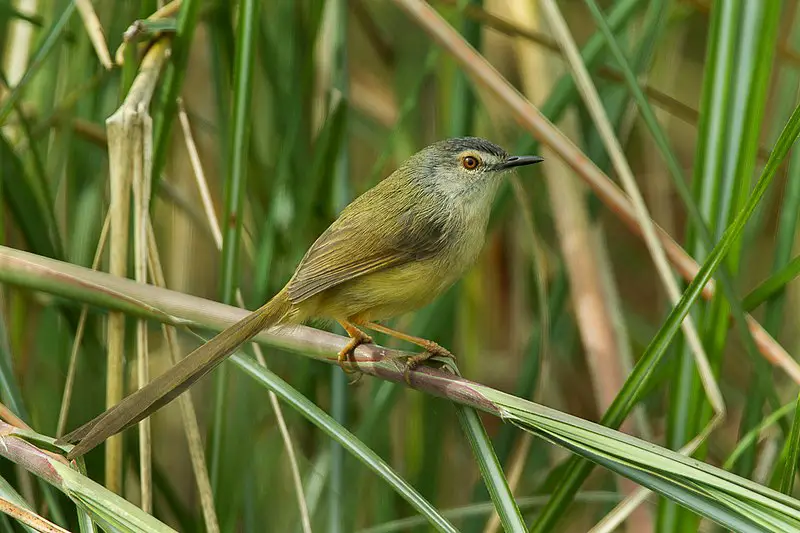
The Yellow-bellied Prinia (Prinia flaviventris) is a species of bird in the family Cisticolidae. It lives mainly in Pakistan, but can also be found along the southern Himalayan foothills and northeastern Indian subcontinent to Southeast Asia.
This small brownish grey bird has a yellow belly with white barring on its wings and tail feathers. Its call is described as being a series of loud chirps or trilling notes which it repeats rapidly for several seconds at a time.
The diet includes flying insects such as moths, beetles, grasshoppers and ants that they catch while hovering over vegetation close to the ground during their search for food.
They are usually seen singly or in pairs near hedges or scrubby areas where there is plenty of cover from predators like snakes and cats.Scientific classification:
| Kingdom | Animalia |
| Phylum | Chordata |
| Class | Aves |
| Order | Passeriformes |
| Family | Cisticolidae |
| Genus | Prinia |
| Species | P. flaviventris |
33. Fulvous-Breasted Woodpecker
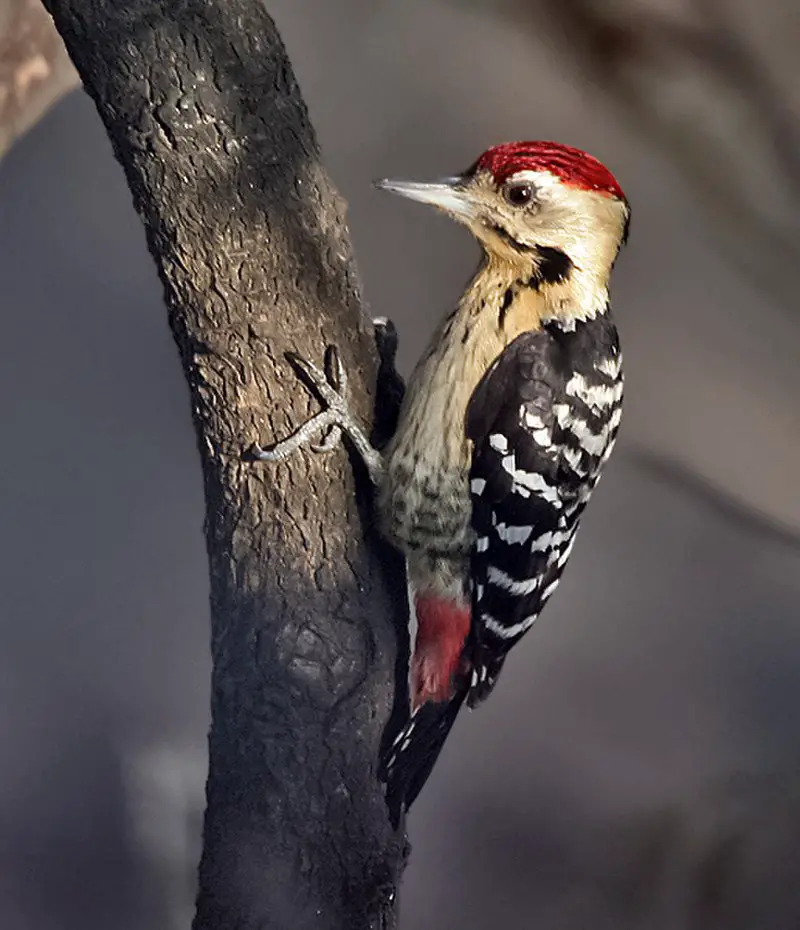
The Fulvous-breasted Woodpecker is a bird of the Picidae family that can be found in Bangladesh, Bhutan, Nepal, India and Myanmar. It has black upperparts with white bars running across it and red undertail feathers.
Its breast and belly are buff coloured with light flank barring while its sides have slight streaks of colouring too.
This medium-sized pied woodpecker is quite common to see when out exploring nature within these countries.
Many people may confuse this species for the Freckle-breasted Woodpecker as they were previously considered conspecifics.
If you’re lucky enough to spot one of these beautiful birds then make sure you take a moment to admire their intricate markings before they fly away on their next adventure.Scientific classification:
| Kingdom | Animalia |
| Phylum | Chordata |
| Class | Aves |
| Order | Piciformes |
| Family | Picidae |
| Genus | Dendrocopos |
| Species | D. macei |
Also Featured In: Birds that You’ll Find in Kolkata,
34. Bengal Bush Lark
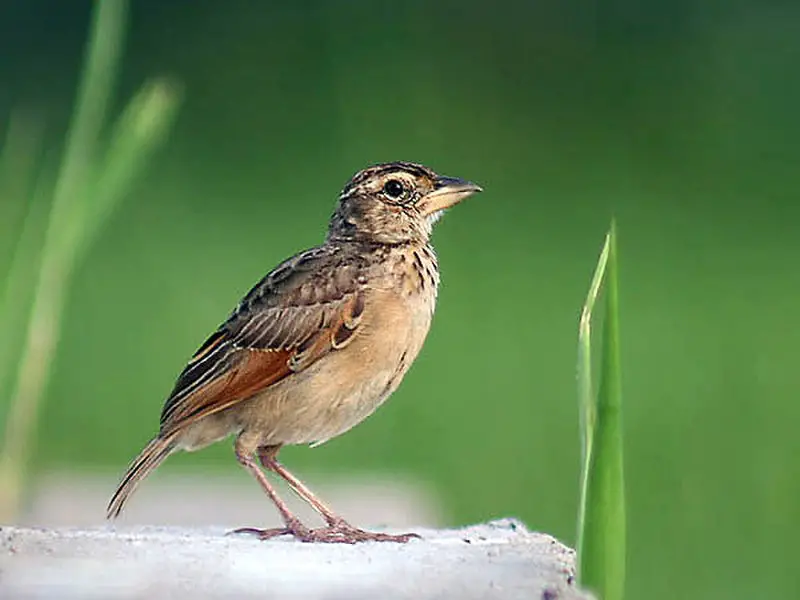
The Bengal bush lark (Mirafra assamica) is a bird belonging to the family Alaudidae, found in southern Asia. It has two races – the Bengal race “assamica” and Madras race “affinis”.
These birds have subtle differences which can only be seen when examined closely. The upper parts of their bodies are brownish-grey with black streaks while they have pale underparts and whitish throat bordered by a narrow buff stripe on each side.
They feed mainly on grass seeds, insects and spiders but also take some berries occasionally. During the breeding season these birds build cup shaped nests mostly near or at ground level among stones or bushes for laying eggs often camouflaged against predators like snakes etc.,
Their melodious songs given out from rooftops makes them popular amongst birdwatchers as well as general people alike.Scientific classification:
| Kingdom | Animalia |
| Phylum | Chordata |
| Class | Aves |
| Order | Passeriformes |
| Family | Alaudidae |
| Genus | Mirafra |
| Species | M. assamica |
35. Blue-Throated Barbet
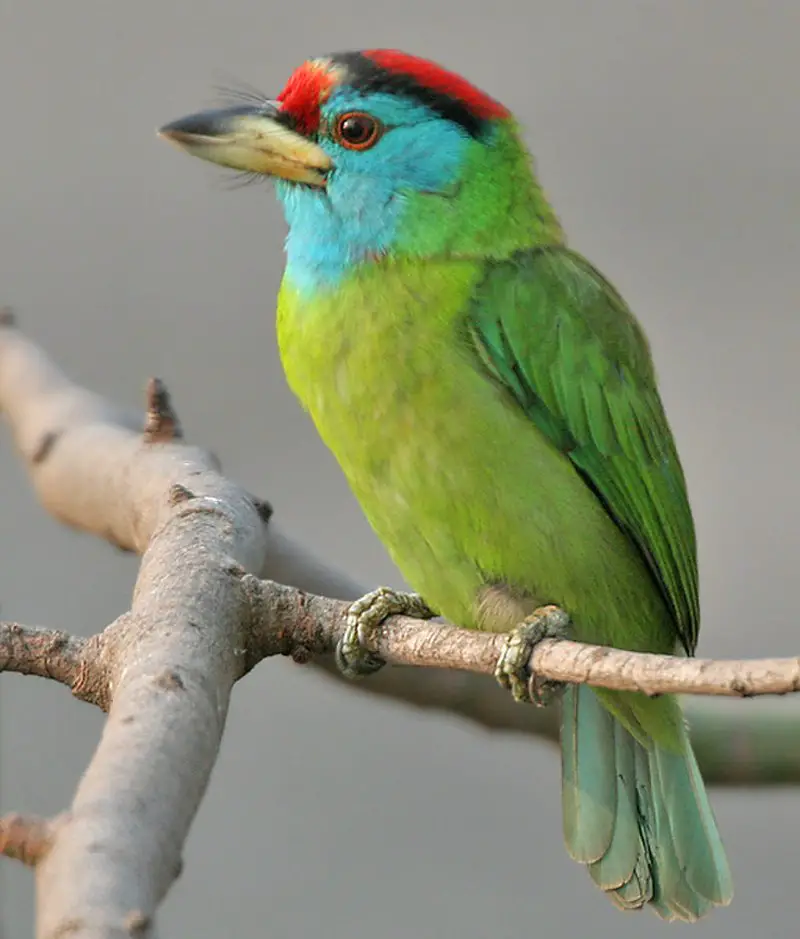
The Blue-throated barbet is a beautiful bird, native to the foothills of the Himalayas and Southeast Asia. It lives in lowland and montane forests from 200m up to 2,000m above sea level.
Its vibrant plumage consists of bright green, blue and red feathers. The species gets its name from the bristles which fringe their heavy bills; they feed on fruits as well as insects for sustenance.
These birds are quite small but have strong voices that can be heard echoing through their habitats day or night.
They’re often seen alone or with other members of their group in trees looking out for food or simply enjoying each others company.
All in all these amazing creatures make an excellent addition to our natural world.Scientific classification:
| Kingdom | Animalia |
| Phylum | Chordata |
| Class | Aves |
| Order | Piciformes |
| Family | Megalaimidae |
| Genus | Psilopogon |
| Species | P. asiaticus |
Also Featured In: Birds that Live in Uttarakhand,
36. Pale-Billed Flowerpecker
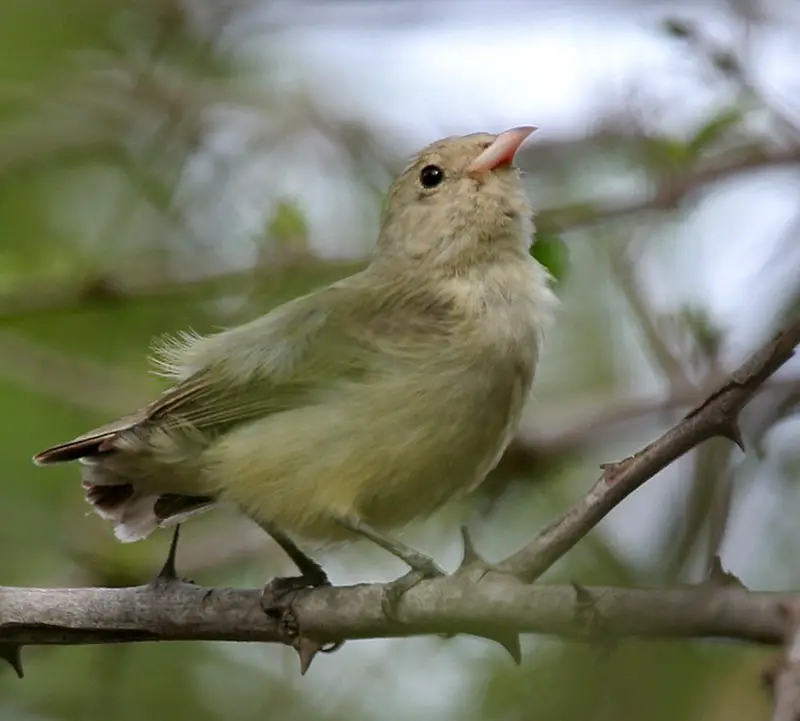
Pale-billed flowerpeckers are small birds with an average length of 8 cm. They have a pinkish curved beak that sets them apart from other similar species in the region.
These little birds can mainly be found throughout India, Sri Lanka, Bangladesh and western Myanmar; they’re especially common in urban gardens where there’s plenty of berry bearing trees for them to feed on.
Not only do they feast on nectar and berries but their loud chipping call is also quite noticeable when spotted around these areas. So next time you spot one out and about make sure to take notice of its unique features.Scientific classification:
| Kingdom | Animalia |
| Phylum | Chordata |
| Class | Aves |
| Order | Passeriformes |
| Family | Dicaeidae |
| Genus | Dicaeum |
| Species | D. erythrorhynchos |
37. Lineated Barbet
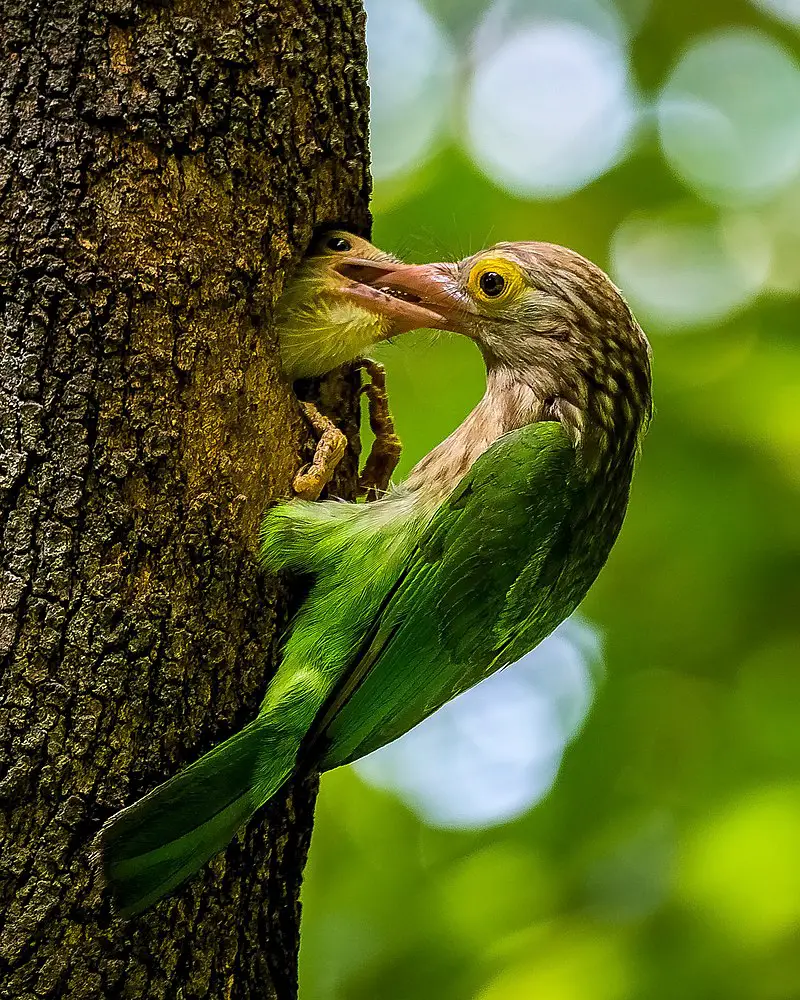
The Lineated barbet is a species of Asian bird native to the Terai, part of the Brahmaputra basin. It has brightly colored feathers with green and yellow stripes along its body, giving it a distinctive look in comparison to other birds.
The diet consists mainly of fruit but also includes some insects and nectar from flowers. They nest by carving holes into tree trunks which they use for protection from predators while raising their young.
These birds are often seen alone or in pairs as they feed on fruits such as mangoes, guavas and figs that grow near wetland areas or woodlands throughout their range.
In addition, these friendly feathered friends make lovely sounds through song-like calls that can be heard over long distances; making them an important source of entertainment in many parts of South Asia.Scientific classification:
| Kingdom | Animalia |
| Phylum | Chordata |
| Class | Aves |
| Order | Piciformes |
| Family | Megalaimidae |
| Genus | Psilopogon |
| Species | P. lineatus |
38. Black-Bellied Tern
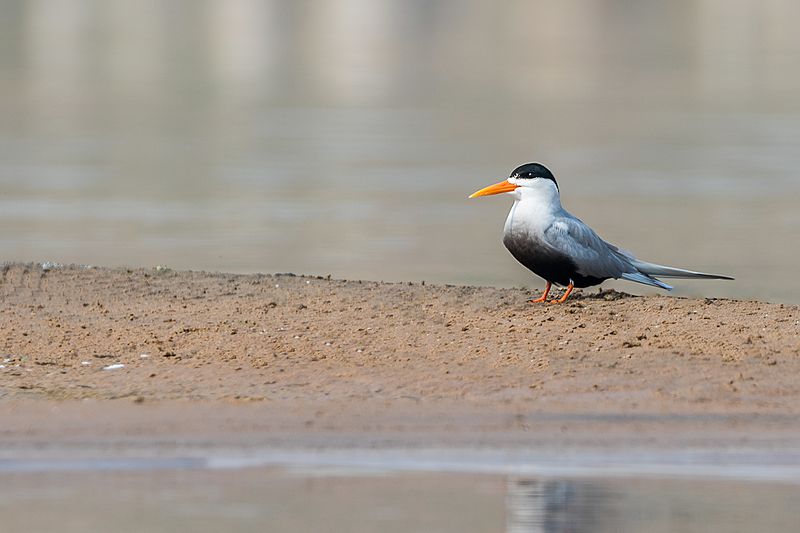
The black-bellied tern is a beautiful bird found in the Indian subcontinent, extending from Pakistan to Myanmar.
It has an elegant forked tail and its feathers come in two distinctive shades – during summer months it boasts a deep black belly which contrasts with its grey upperparts.
Unfortunately this species has become very rare, leading the International Union of Conservation of Nature to classify them as endangered.
They are often seen near large rivers where they fish for small insects and crustaceans. This stunning bird deserves more attention so that conservation measures can be put into place to ensure their future survival.Scientific classification:
| Kingdom | Animalia |
| Phylum | Chordata |
| Class | Aves |
| Order | Charadriiformes |
| Family | Laridae |
| Genus | Sterna |
| Species | S. acuticauda |
39. Black Drongo

The Black Drongo is a small passerine bird of the Dicruridae family, commonly found in tropical southern Asia from Iran through India and Bangladesh to Indonesia.
It has an all black plumage and distinctive forked tail measuring 28 cm long. This omnivorous species feeds on insects such as flies, bees, beetles and moths; it also consumes fruit juices during summer months.
The nest can be built anywhere including open fields or near houses made up of twigs with a cup-shaped inner lining using grasses & hair filled with feathers & cobwebs.
During breeding season they are known to perform aerial acrobatics while chasing away any intruders who come too close to their nests.Scientific classification:
| Kingdom | Animalia |
| Phylum | Chordata |
| Class | Aves |
| Order | Passeriformes |
| Family | Dicruridae |
| Genus | Dicrurus |
| Species | D. macrocercus |
Also Featured In: Asian Birds, Delhi Birds You Need to See
40. Rose-Ringed Parakeet
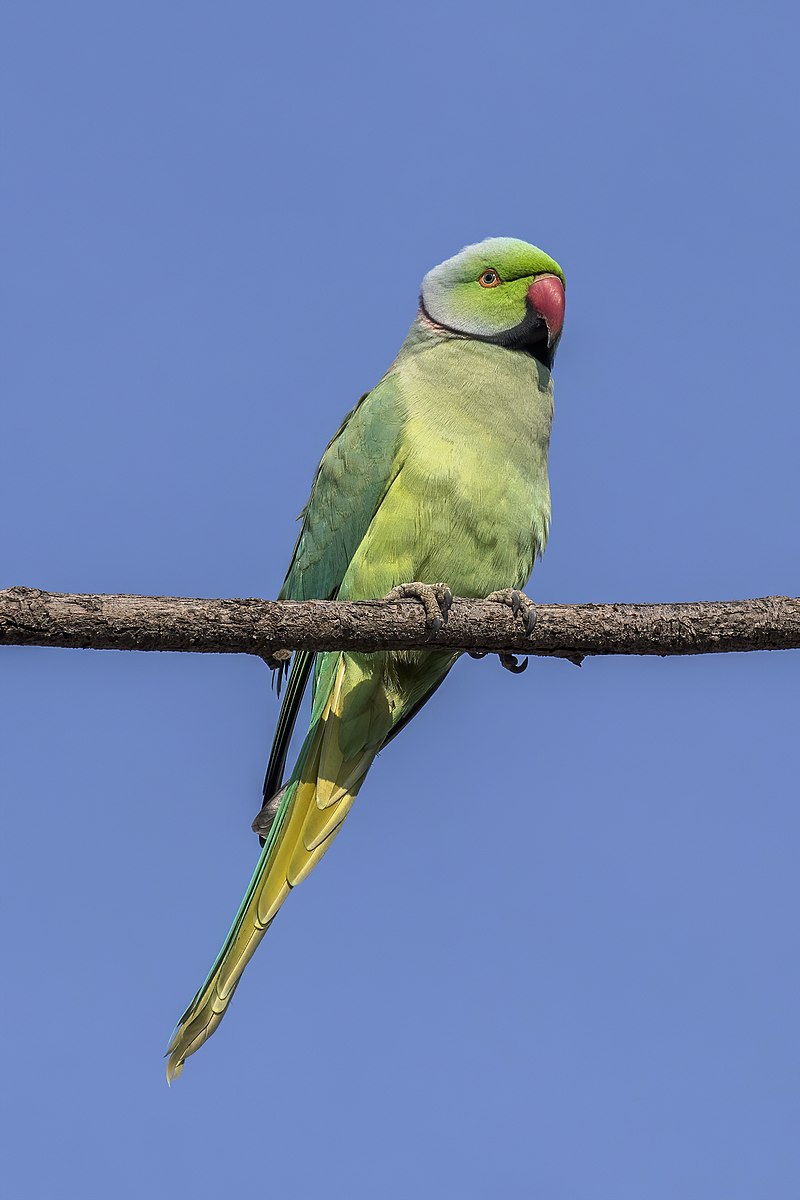
The Rose-ringed parakeet is a medium sized bird in the family Psittacidae. Native to Africa and India, it has been introduced into many other parts of the world where feral populations have now established themselves.
The most distinctive feature of this species is its colorful neck ring ranging from pink to purple which gives them their name.
However, males often display more vibrant colors than females do. This beautiful bird can also imitate human speech quite well making them popular pets worldwide.
In addition they are very social creatures preferring large flocks when out in nature or as part of aviaries during captivity. With proper care these birds can live up to 30 years.Scientific classification:
| Kingdom | Animalia |
| Phylum | Chordata |
| Class | Aves |
| Order | Psittaciformes |
| Family | Psittaculidae |
| Genus | Psittacula |
| Species | P. krameri |
41. Rufous Treepie
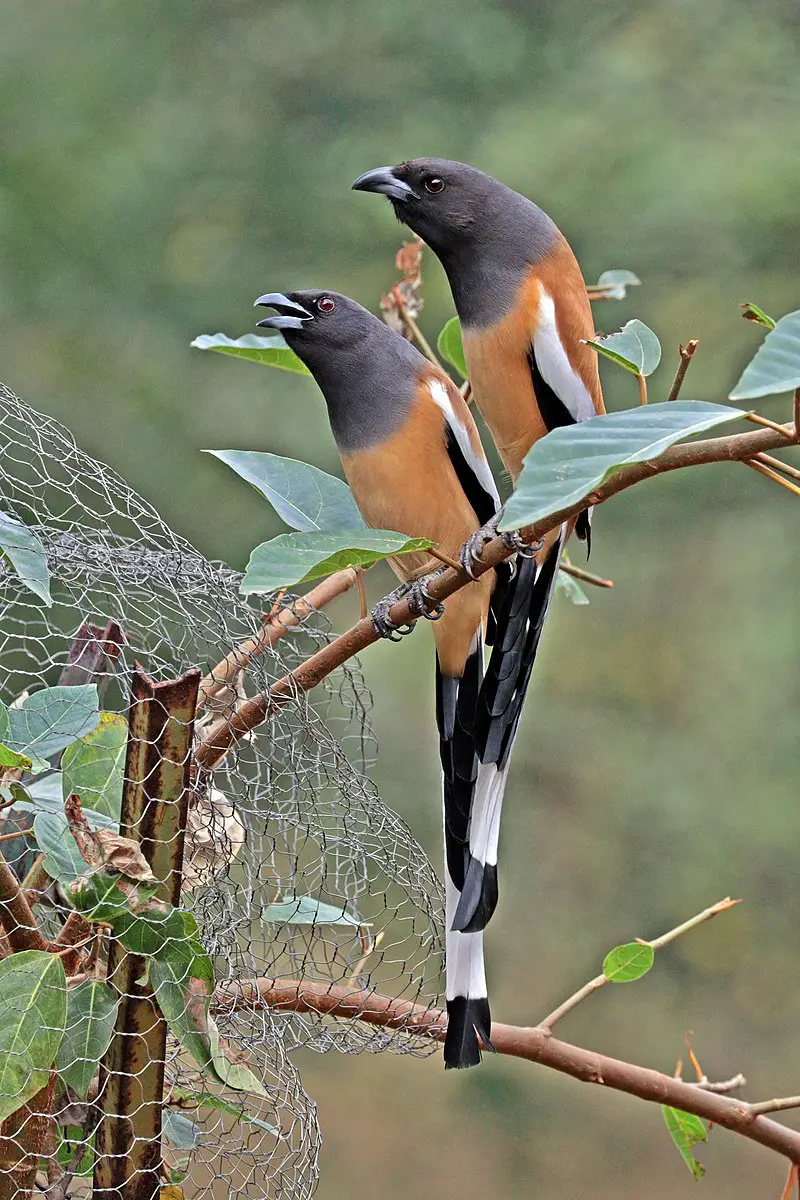
The Rufous Treepie is a member of the Corvidae family and native to the Indian Subcontinent, as well as parts of Southeast Asia. It has distinctive loud musical calls that make it easily recognizable.
This bird can be found in open scrub lands, agricultural areas, forests and even urban gardens due to its adaptability and omnivorous diet.
With its long tail feathers ranging from brown-black to greyish-brown on top with orange underneath; this species stands out among other birds.
They also have an interesting way of eating fruits: they peck at them while hovering midair. The Rufous Treepie is not only beautiful but also quite intelligent – their problem solving abilities are second only to those of primates.Scientific classification:
| Kingdom | Animalia |
| Phylum | Chordata |
| Class | Aves |
| Order | Passeriformes |
| Family | Corvidae |
| Genus | Dendrocitta |
| Species | D. vagabunda |
42. Lesser Adjutant
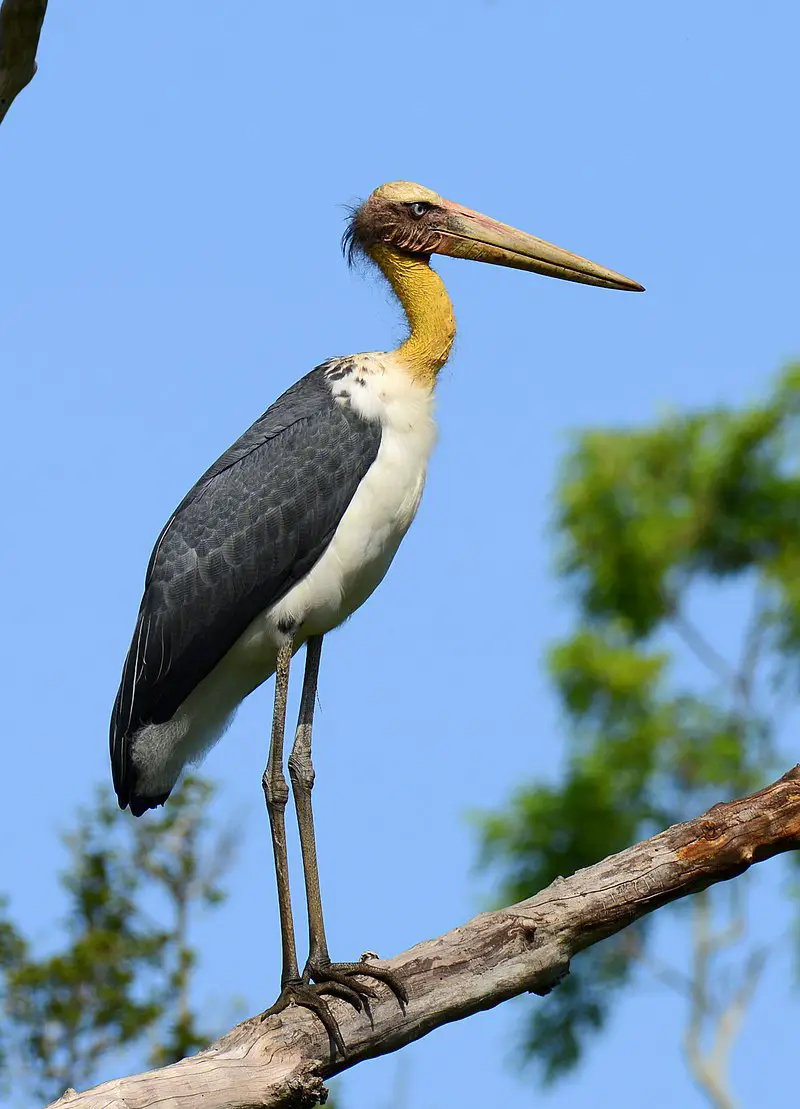
The Lesser Adjutant is a large wading bird found in the stork family Ciconiidae. It has an unmistakable profile, with its bare neck and head distinguishing it from other species of its genus.
This impressive bird is solitary in nature, preferring to live near wetland habitats where it can feed on fish, frogs and insects that inhabit these areas.
The Lesser Adjutant lives all over India as well as Southeast Asia into Java making them a widespread species.
They are also less likely scavengers than their larger counterpart –the Greater Adjutant Bird -making them more unique amongst their peers.
Not only do they possess this interesting trait but due to their size and ability to fly long distances they play an important role within local ecosystems across Asia keeping things balanced and healthy for future generations.Scientific classification:
| Kingdom | Animalia |
| Phylum | Chordata |
| Class | Aves |
| Order | Ciconiiformes |
| Family | Ciconiidae |
| Genus | Leptoptilos |
| Species | L. javanicus |
Also Featured In: Java Birds You Should Know, Most Common Birds of Bihar
43. Common Tailorbird
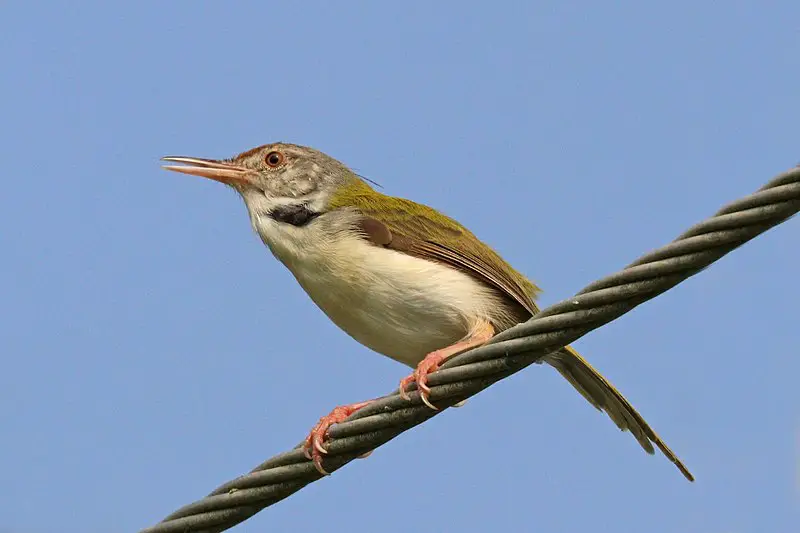
The Common Tailorbird is a songbird found across tropical Asia, popular for its unique nests made of leaves “sewn” together.
It was immortalized by Rudyard Kipling in his Jungle Book as Darzee and can often be seen in urban gardens.
Though shy birds that are usually hidden within vegetation, their loud calls give away their presence.
They are distinctive with a brownish plumage on the upperparts and paler gray underparts; white throats speckled black mark them out from other similar species.
They feed mainly on insects such as spiders, caterpillars and grasshoppers but will also eat fruit when available.
Breeding season begins around March or April with males singing to claim territories before beginning to weave intricate leafy structures for nesting sites – an amazing feat.
All in all these delightful little birds make wonderful additions to any garden setting – just remember not to get too close.Scientific classification:
| Kingdom | Animalia |
| Phylum | Chordata |
| Class | Aves |
| Order | Passeriformes |
| Family | Cisticolidae |
| Genus | Orthotomus |
| Species | O. sutorius |
Also Featured In: Common Birds of Mumbai, Urban Birds of Hong Kong
44. Mangrove Pitta
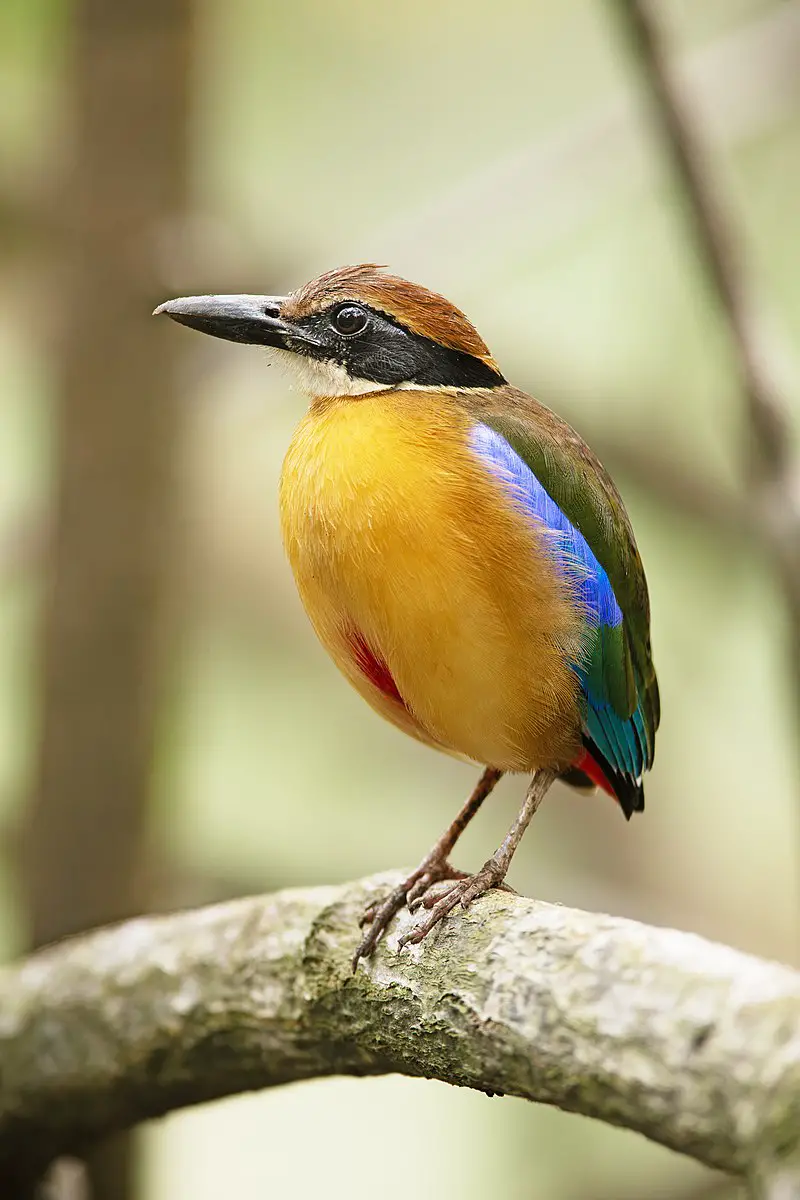
The Mangrove pitta is an exquisite passerine bird with a striking black head and brown crown. There throat is white, while their upper part has a vibrant greenish hue that makes them stand out in the crowd.
This species belongs to the Pittidae family, which includes Indian pittas, fairy pittas and blue-winged ones – however it does not have any subspecies of its own.
Endemic to eastern India and western Southeast Asia, this chirpy little creature loves spending time near mangroves where they can easily find food from their favourite diet consisting mostly of insects.
Their beautiful feathers make them quite attractive to potential predators as well so they must be on high alert whenever they venture outside.Scientific classification:
| Kingdom | Animalia |
| Phylum | Chordata |
| Class | Aves |
| Order | Passeriformes |
| Family | Pittidae |
| Genus | Pitta |
| Species | P. megarhyncha |
45. White-Winged Duck
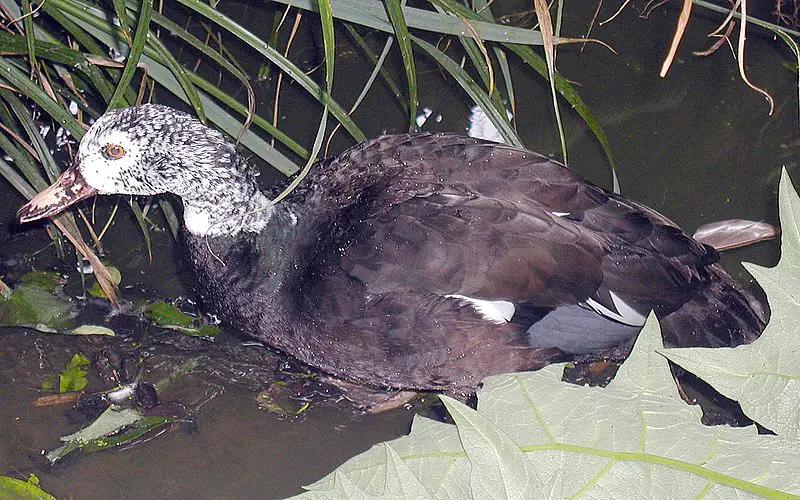
The white-winged duck is a large species of bird once classified in the same genus as Muscovy ducks.
It has distinctive white wing feathers and is otherwise mainly brown with some darker patches on its wings, back and head.
These birds are found primarily in tropical southern Asia, where they inhabit lakes, rivers and wetlands.
They feed mostly on aquatic plants but may also take insects or small fish when available.
Despite their size, these ducks fly well – although not for long distances – making them an impressive sight to behold when taking off from water bodies.Scientific classification:
| Kingdom | Animalia |
| Phylum | Chordata |
| Class | Aves |
| Order | Anseriformes |
| Family | Anatidae |
| Genus | Asarcornis Salvadori, 1895 |
| Species | A. scutulata |
46. Ruddy Kingfisher
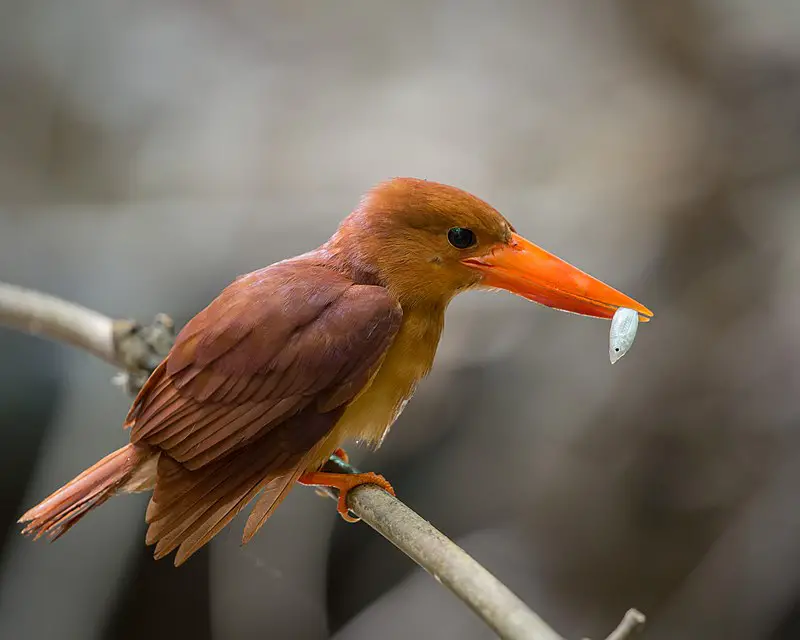
The Ruddy kingfisher is a beautiful species of bird found in east and southeast Asia. It measures up to 25 cm long, with bright red bill and legs that contrast against its rust-red body which deepens into purple at the tail.
There isn’t much sexual dimorphism between male and female birds, although some sources report males being brighter plumage than females.
These birds usually inhabit coastal mangrove forests or riverine habitats where they feed on aquatic insects like dragonflies as well as small fish.
They are typically solitary but may form pairs during breeding season when their loud calls can be heard from afar.Scientific classification:
| Kingdom | Animalia |
| Phylum | Chordata |
| Class | Aves |
| Order | Coraciiformes |
| Family | Alcedinidae |
| Subfamily | Halcyoninae |
| Genus | Halcyon |
| Species | H. coromanda |
Also Featured In: Common Birds Found near Ishigaki,
47. Chestnut-Winged Cuckoo
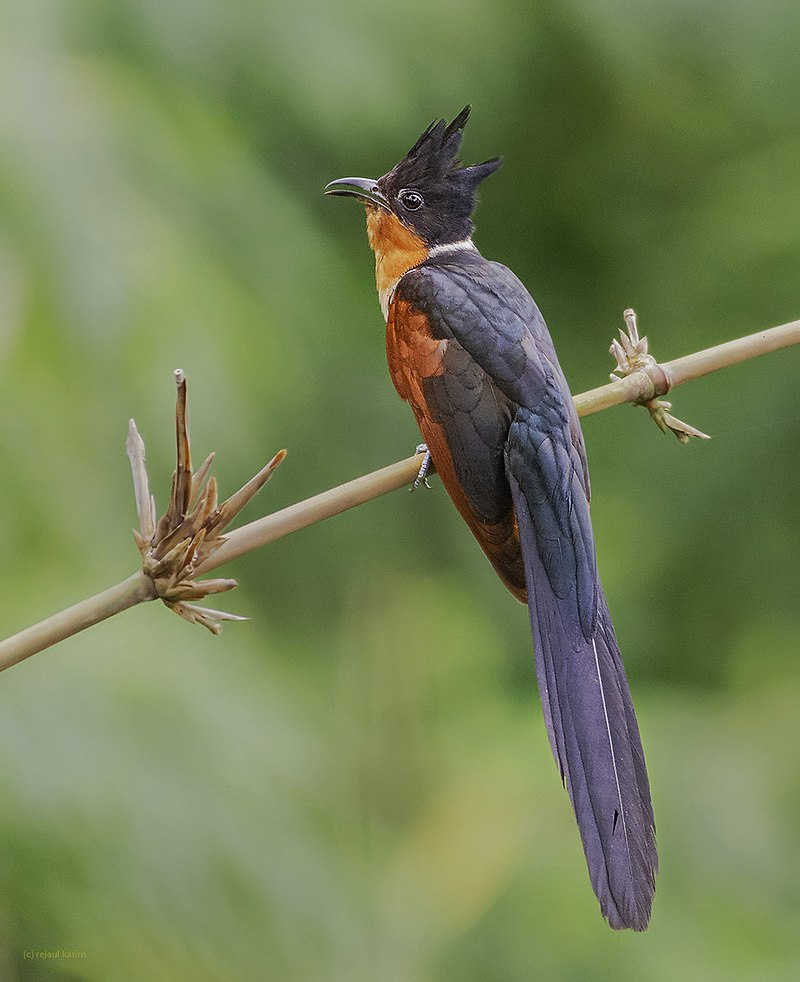
The Chestnut-winged cuckoo is a beautiful bird found in Southeast Asia and parts of South Asia.
It has glossy black head with long crest, chestnut wings, rufous throat and dusky underside as well as narrow white nuchal half collar which make it distinct from other birds.
It breeds along the Himalayas during summer season and migrates south to Sri Lanka during winter season.
This species prefers dense forest habitat but can also be seen in open woodlands or grassland areas where they feed on small invertebrates such insects and worms.
They are known for their loud calls that are heard throughout the day especially early morning when they seek mates or announce territory presence.Scientific classification:
| Kingdom | Animalia |
| Phylum | Chordata |
| Class | Aves |
| Order | Cuculiformes |
| Family | Cuculidae |
| Genus | Clamator |
| Species | C. coromandus |
48. Indian Pied Myna
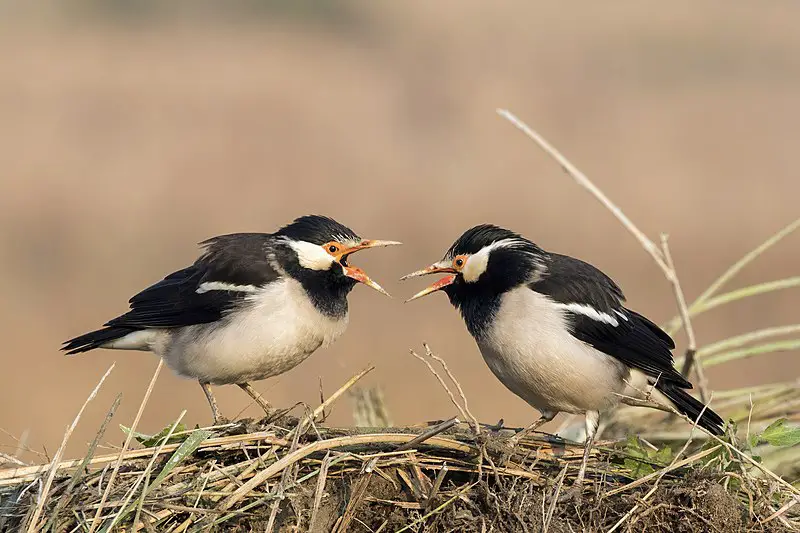
The Indian pied myna is a species of starling native to the Indian subcontinent. It’s usually found in small groups, mainly on plains and low foothills near cities and villages.
They’re known for their beautiful liquid notes that they produce as calls. The Swedish naturalist Carl Linn formally described this bird in his works centuries ago, giving us an insight into its beauty even then.
Its plumage consists of greyish-black wings with white patches at the tips, a glossy black head with yellow eyes and beak along with whitish underparts which makes it easily recognizable amongst other birds around it.
This attractive bird continues to captivate many people today through its vibrant appearance and melodic song.Scientific classification:
| Kingdom | Animalia |
| Phylum | Chordata |
| Class | Aves |
| Order | Passeriformes |
| Family | Sturnidae |
| Genus | Gracupica |
| Species | G. contra |
49. Indian Roller
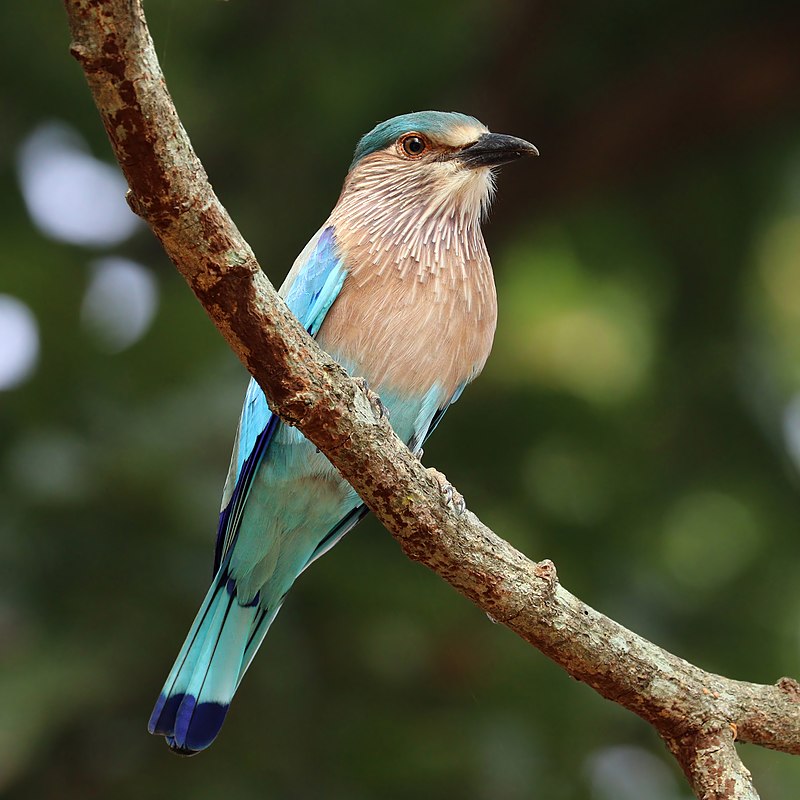
The Indian roller is a beautiful bird of the Coraciidae family. It has an average length of 12-13 inches and weighs 5.9 to 6.2 ounces with a wingspan of 26-29 inches.
Its face and throat are pinkish, while its head and back are brown with blue on its rump, light blue markings on one side of the wing, dark blue markings on other side making it easily distinguishable in flight.
Both male and female have same colouration but males tend to be slightly larger than females though they can only be differentiated when seen together closely due to similar colouring pattern between sexes.
The Indian Roller makes spectacular aerial dives from great heights during courtship display which attracts many viewers each year.Scientific classification:
| Kingdom | Animalia |
| Phylum | Chordata |
| Class | Aves |
| Order | Coraciiformes |
| Family | Coraciidae |
| Genus | Coracias |
| Species | C. benghalensis |
50. Greater Coucal
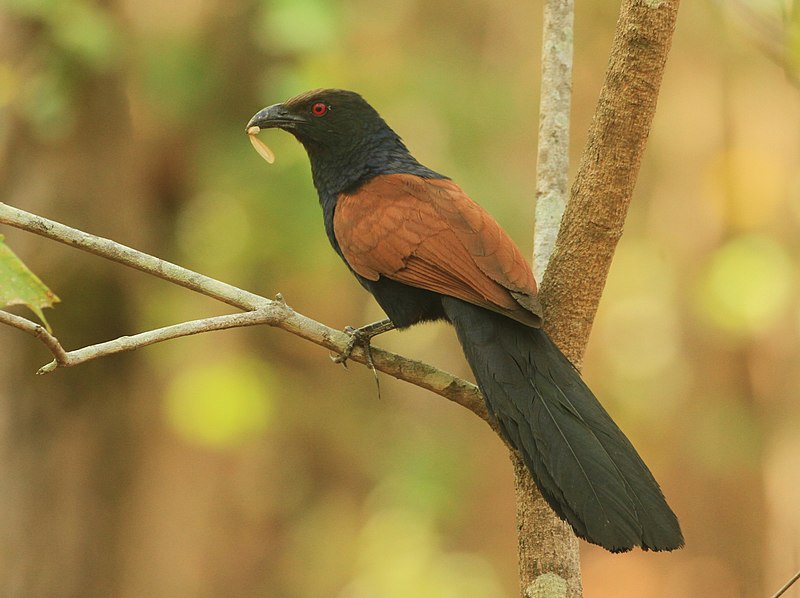
The Greater Coucal is a large, crow-like bird that belongs to the Cuculiformes order. It has a long tail and coppery brown wings.
These birds are found in many habitats across India and Southeast Asia, ranging from jungles to suburban gardens.
They feed on insects as well as small vertebrates such as frogs, lizards or snakes which they capture with their strong beak.
The males have glossy black plumage while females are dark brown above with buff underparts.
During breeding season these birds make loud croaking calls and can often be heard at night when they become active after sundown looking for food sources like termites or grasshoppers between bushes or low branches of trees close by water bodies like rivers, lakes etc.
This species plays an important role in maintaining ecological balance in its habitat by controlling pest populations through predation so it is essential that we protect them from hunting and other threats for future generations to enjoy.Scientific classification:
| Kingdom | Animalia |
| Phylum | Chordata |
| Class | Aves |
| Order | Cuculiformes |
| Family | Cuculidae |
| Genus | Centropus |
| Species | C. sinensis |
51. Grey-Headed Parakeet
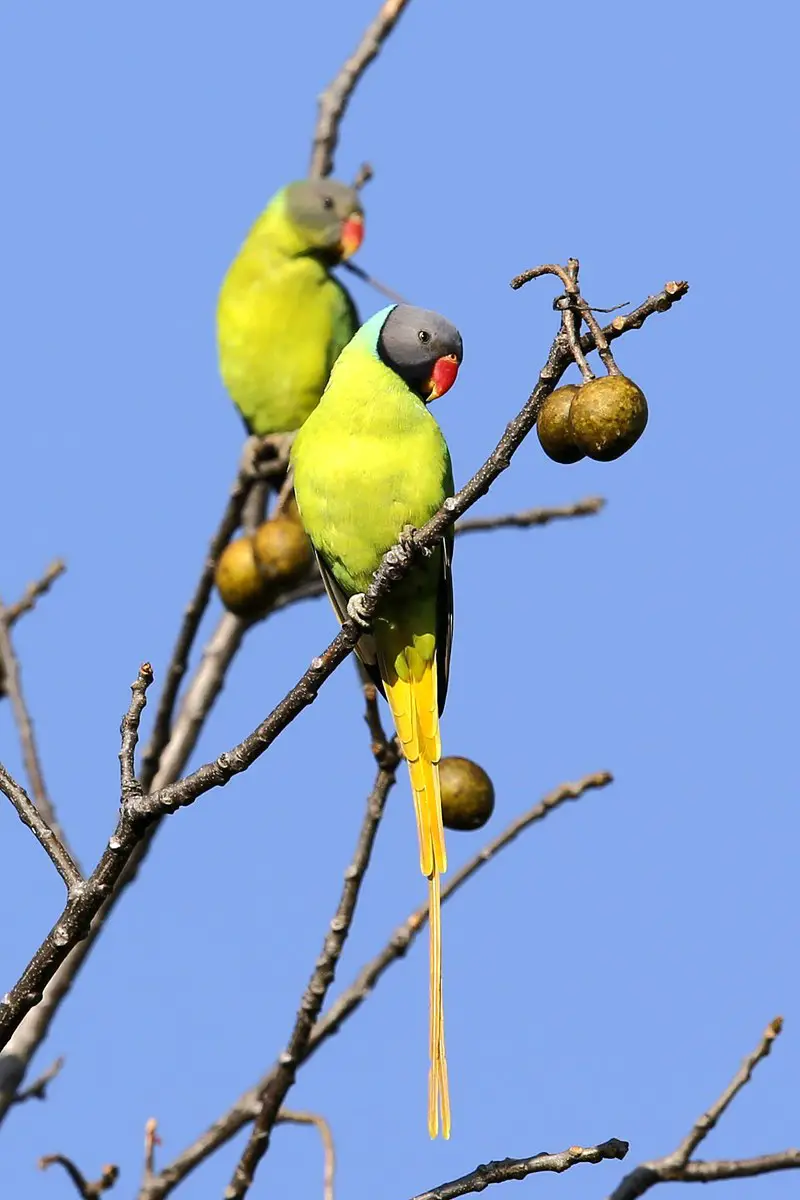
The Grey-headed Parakeet is an amazing bird found in Southeast Asia, ranging from Northeastern India to Vietnam. It belongs to the super-species with Slaty-Headed Parakeets and its binomial name pays homage to German naturalist Otto Finsch.
The face of this bird is greyish green while rest of its head has a dull green hue with faint pale green band below cheeks going towards the back crown.
This parakeet loves living in humid climates near subtropical forests that have plenty of berries or fruits for them to eat as they are primarily frugivorous birds.
They also nest high up in tree cavities making it difficult for predators like snakes and raptors reach them easily. Their call sounds sweet but can be quite loud at times when there’s a group together; however, their beauty more than makes up for any noise disturbance caused.Scientific classification:
| Kingdom | Animalia |
| Phylum | Chordata |
| Class | Aves |
| Order | Psittaciformes |
| Family | Psittaculidae |
| Genus | Psittacula |
| Species | P. finschii |